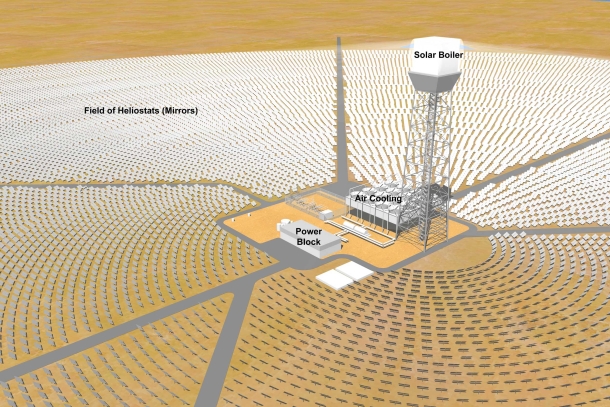Our Analysis of the Ivanpah SEGS Final Staff Assessment/Draft Environmental Impact Statement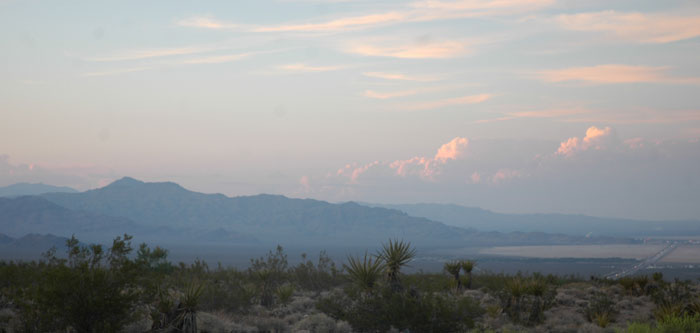
Ivanpah Solar Electric Generating System Background Information
June 2010 - Heliostat Pole Testing
Simulation of Finished Project
August 2010 - Tortoise Fencing Survey Stakes Up
Spiritual Run for Ivanpah Valley
Construction Begins - October 2010
November-December 2010 Vegetation Clearing Before and After Photos
March 2011 Construction Progress Photos
March 2011 Aerial Photos of Construction Progress
Proposal for an Ivanpah Valley Area of Environmental Concern
Last Summer at Ivanpah, Blog Entry by Chris Clarke at Coyote Crossing >>here
California Energy Commission website
^Ivanpah Solar Electric Generating System power tower. But the graphic makes the area look devoid of vegetation, see below.
Tortoise Impacts Higher Than Expected
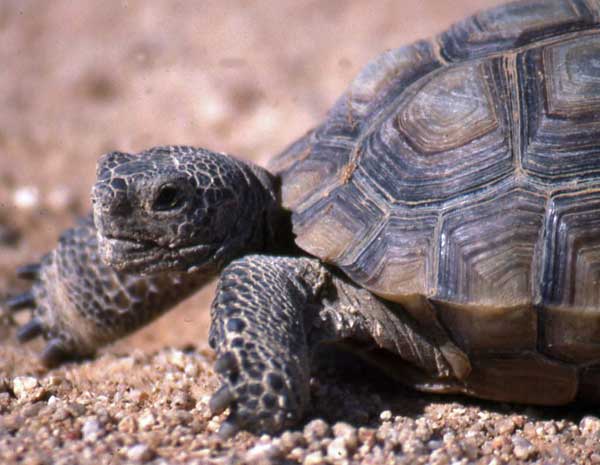
April 30, 2011 - The numbers are coming out of how a large desert solar project impacts the Federally Threatened Desert tortoise (Gopherus agassizii). The contracting biologists working for BrightSource must revise and prepare a Biological Assessment for Bureau of Land Management, that will then be reviewed by US Fish and Wildlife Service, the agency responsible for giving the permit for allowing a certain number of tortoises to be "harmed," harassed" or killed due to a project action. In this case, the Ivanpah Solar Electric Generating System passed its allotted "take" limit of tortoises earlier this month, and BLM issued a temporary halt on construction over two thirds of the project. US Fish and Wildlife Service could issue a revised permit, or stop all construction until the project is modified.
From: Revised Biological Assessment for the Ivanpah Solar Electric Generating System (Ivanpah SEGS) Project, April 19, 2011. Prepared for Bureau of Land Management. Prepared by Sundance Biology, Inc., Kiva Biological Consulting, and CH2MHill.
http://www.blm.gov/ca/st/en/prog/energy/fasttrack/ivanpahsolar/fedstatus.html
"Take" is defines in several ways under the Endangered Species Act -
Harm:
- 3,344 acres of desert tortoise habitat will be permanently removed, 176 acres more temporarily disturbed, for 370 MW.
- 281 tortoise burrows destroyed in Unit 1.
- 1,000 burrows total may be destroyed on the project site.
- 57-274 adult tortoises will likely be translocated.
- 236 eggs may be destroyed in the project.
- As many as 608 juvenile tortoises (under 160 mm carapace) will likely be killed or translocated. Juvenile tortoises will suffer an estimated 90% mortality on the project site.
Harass:
The "Action Area" impacted (defined according to ESA), will include 66,688 acres = project site, translocation areas, control areas, and all areas tortoises may move into after being translocated. For a single solar project. Two more solar projects are pending nearby by First Solar.
This Action Area is estimated to have 1,025 adult and 2,349 juvenile tortoises.
114-548 adult and up to 200 juvenile tortoises may be harmed and harassed by being captured as part of the effectiveness monitoring study on the resident and control groups (not translocated, but disease-tested and radiotransmittered). As many as 162 adult tortoises in the resident population, and another 162 adults in the control site would be captured for disease testing and monitoring.
Kill:
An estimated 3 adults/year will be killed during the 3 years of construction, and 547 juveniles killed per year. Two, possibly 3 tortoises have already been killed since start of construction in October. Some wrangling over how the tortoises died and whether they were caused by the project action may be ongoing.
This was determined from:
35 tortoises were cleared (found and/or dug out of their burrows) from Unit 1 and Construction Logistics Area in 2010 (only 6 showed themselves in this area during all the 2007and 2008 presence/absence surveys; 28 total for whole project). Obviously these surveys do not work. In 2010 the 35 tortoises included 20 adults and 15 juveniles. This works out to 10.8 adult tortoises/square km. The average density for the Northeastern Mojave Recovery Unit is 1.7 tortoises/square km. Ivanpah Valley was a prime and dense tortoise population. Only mark-recapture techniques could have discovered an estimate closer to this density, but they are not required by US Fish and Wildlife Service.
The estimate of total adult tortoises on the project site may be 60-64. The original estimate of total tortoises on the project site was 32 adults.
Outside the project boundary in translocation areas, 33 tortoises have been found in 19.5 sq km. The total translocation area will be 43 sq km surrounding the project site. Using Line Distance Sampling data, an estimated minimum of 270 tortoises may be found here, and 2,055 juveniles, within 2 km around the project site.
BrightSource IPO on Earth Day
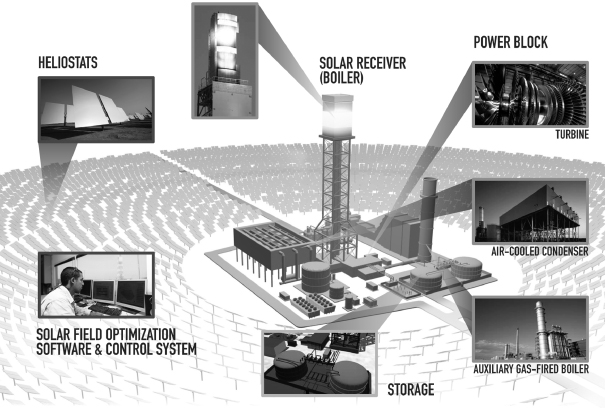
April 24, 2011 - BrightSource Energy filed for an initial public offering of $250 million on April 22 with the US Securities and Exhcange Commission. NRG Solar (a subsidiary of NRG Energy) and Google are together the controlling equity investors. VantagePoint Capital Partners and Alstom also own large percentages of the company.
BrightSource says in its registration statement:
We have produced high-temperature steam using our technology since 2008, when we commenced operations at our 6 megawatt thermal, or MWth, demonstration solar-to-steam facility, the Solar Energy Development Center, in Israel. We believe this facility has consistently produced the highest temperature and pressure steam of any solar thermal facility in the world, capable of driving highly-efficient, cost-effective turbines. This facility validated our technology and continues to provide important operational and production data.
Since our founding in 2004, we have executed 14 long-term power purchase agreements, or PPAs, to deliver approximately 2.6 GW of installed capacity to two of the largest electric utilities in the United States, Pacific Gas and Electric Company, or PG&E, and Southern California Edison, or SCE. We believe these PPAs represent the largest utility-scale solar pipeline in the United States and over $4 billion of revenue opportunity for us through sales of our systems. As the first step in fulfilling our obligations under the PPAs, in 2007 we commenced the permitting and financing of Ivanpah, a project comprised of three concentrating solar thermal power plants on a 3,600 acre site in California’s Mojave Desert. After receiving our permits, we initiated construction of Ivanpah in October 2010. In April 2011, Ivanpah was partially financed with a $1.6 billion loan guaranteed by the U.S. Department of Energy, or the DOE. Consistent with our business development strategy in the United States, we also sold a controlling interest in the equity of Ivanpah to a consortium of investors led by NRG Solar. When commissioned, Ivanpah will have a gross installed capacity of 392 MW and will increase the amount of solar thermal generation capacity currently installed in the United States by over 75%.
We have a development site portfolio of approximately 110,000 acres under our control in California and the U.S. Southwest that has the potential to accommodate approximately 11 GW of installed capacity. We currently have two sites in advanced development, Rio Mesa Solar and Hidden Hills Ranch, each located in California. Rio Mesa Solar consists of approximately 6,600 acres, and Hidden Hills Ranch consists of approximately 10,000 acres.
In 2007, we entered the thermal EOR business after Chevron selected our technology through a competitive process. After winning the business, we signed a contract with Chevron in 2008 to provide a 29 MWth EOR facility in Coalinga, California. We commenced construction of the Coalinga Solar-to-Steam for EOR project in 2009, and the project is scheduled to begin operations in the second half of 2011.
In addition to our relationship with Chevron, we have strategic relationships with global, industry-leading companies, including Alstom, Bechtel and NRG Solar. In order to accelerate the adoption of our systems, we are leveraging these relationships and our world-class partners’ local expertise in domestic and international markets to pursue expansion opportunities more rapidly and cost-effectively than might otherwise be possible.
.....
....construction of Ivanpah commenced in October 2010. However, continued construction of portions of the second and third phases of Ivanpah require further approval from the U.S. Bureau of Land Management, or BLM, the California Energy Commission, or CEC, and the U.S. Fish & Wildlife Service, or FWS. Any delay by the BLM, CEC and/or FWS in delivering required approvals or opinions could have a material adverse effect on the schedule for Ivanpah’s second and third phases and our business.
Once construction is completed, Ivanpah will be operated by NRG Solar, and therefore we will have limited influence over Ivanpah’s future operations.
.....
We depend heavily on federal, state and local government support for renewable energy sources, which are subject to change;...
Negative public or community response to solar thermal projects could adversely affect widespread adoption of systems using our technology.
Negative public or community response to solar thermal energy projects could adversely affect our ability to sell our systems to projects using our technology and for our project companies to develop, construct and operate their projects. This type of negative response could lead to legal, public relations and other challenges that impede our project companies’ ability to meet our development and construction targets, achieve commercial operations for a project on schedule and generate revenues. For example, Ivanpah has been, and continues to be, the subject of administrative and legal challenges from groups concerned with potential environmental impacts (e.g., impacts on the California desert tortoise and other wildlife species affected by Ivanpah as originally proposed), archaeological or cultural impacts or impacts on the natural beauty of public lands. We expect this type of opposition to continue as we develop and construct existing and future projects using our systems. An increase in opposition to our requests for permits or successful challenges or appeals to permits issued to us could materially adversely affect our development plans. If we are unable to develop and construct the production capacity to the scale that we expect from our development projects in our anticipated timeframes, our business, financial condition and results of operations could be materially adversely affected.
....
Current or future litigation or administrative proceedings could have a material adverse effect on our business, financial condition and results of operations.
We have been, and continue to be, involved in legal proceedings, administrative proceedings, claims and other litigation that arise in the ordinary course of business. Individuals and interest groups may choose to litigate the issuance of a permit for a solar thermal energy project or seek to enjoin construction of a solar thermal energy project, among other potential issues. For example, in January 2011, two lawsuits challenging the issuance of certain permits for Ivanpah were filed. The plaintiffs in the first proceeding allege that the permitting process for four large scale solar projects on federal land in California, including Ivanpah, did not comply with various federal requirements, including National Environmental Policy Act, or NEPA, Federal Land Policy Management Act, or FLPMA, the National Historic Preservation Act and the Native American Graves Protection and Repatriation Act. The second suit was brought by the Western Watersheds Project, a non-profit organization, against the U.S. Department of Interior, or DOI, alleging that the permitting process for Ivanpah did not comply with requirements under the NEPA, the Endangered Species Act, the FLPMA and the Administrative Procedure Act. While we believe the claims are without merit, unfavorable outcomes or developments relating to these proceedings, such as judgments for monetary damages, injunctions or denial or revocation of permits, could have a material adverse effect on our business, financial condition and results of operations. In addition, settlement of claims could adversely affect our financial condition and results of operations. See “Business—Legal Proceedings.”
....
Our largely unproven mirror cleaning equipment may perform below our expectations.
The primary maintenance activity for solar thermal projects using our systems will be the routine and continuous washing of reflective mirror surfaces. We anticipate each mirror may need to be cleaned every two weeks to prevent a buildup of dust which would significantly degrade the system performance. Mirrors will be washed at night by a dedicated crew using specialized mobile equipment. A truck is being designed that will bring purified water simultaneously to a number of mirrors. We are still designing and testing the specialized equipment to be used in this process. If the mirror washing equipment and process are not effective, actual operating costs may be substantially higher than forecasted or total electrical production may fall short of estimates.
....
$1,600,000,000 DOE loan guarantee secured.
$598,000,000 total equity commitment - $300,000,000 from NRG, $168,000,000 from Google, $130,000,000 from BrightSource.
$570,000,000 US Treasury cash grant payable 60 days after project is placed in service.
All three Ivanpah phases have fully committed equity and debt financing of approximately $2.2 billion to fund construction costs, together with other project costs such as interest during construction, sales tax, mitigation and development costs, interconnection costs, cost contingencies and debt reserves.
http://www.sec.gov/Archives/edgar/data/1471443/000119312511106341/ds1.htm
BLM Orders Halt on New Construction
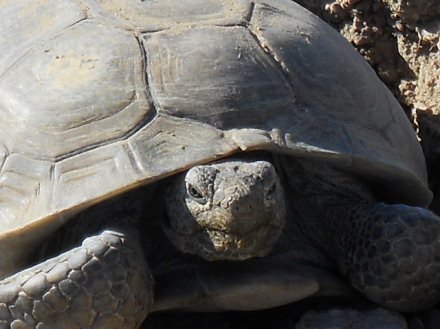
April 19, 2011 - Bureau of Land Management sent out a decision dated April 15 for an "Immediate Temporary Suspension of Activities" at the Ivanpah Solar Electric Generating System Project, specifically ground-disturbance on Units 2 and 3. Construction activities may continue on Unit 1 and the power block of Unit 2 which have already been cleared of tortoises and fenced.
The grants given by BLM were suspended for Units 2 and 3 due to failure to comply with the Biological Opinion (a legally binding contract, pursuant to Section 7 of the Endangered Species Act, issued by the US Fish and Wildlife Service). BLM ordered a halt to all fence-building on Units 2 and 3, which were underway but not complete, after reviewing monthly monitoring information regarding desert tortoise submitted by BrightSource. BLM said the incidental take limits established for the project were "reached, and in some categories, just exceeded" for further construction.
BLM is allowing work to continue in Unit 1, the access road, Construction Logistics Area, and Unit 2 powerblock which is already fenced and graded. All tortoises had been removed from those areas previously.
The BLM statement orders BrightSource to expedite new tortoise surveys on Units 2 and 3 to determine the number of tortoises on the remaining project footprint. It also orders new tortoise surveys 2 kilometers out surrounding the entire project to determine the tortoise numbers in the resident population.
BLM said it has reinitiated consultation with US Fish and Wildlife on the project as a whole. The Decision shall remain in effect until permission to resume activities by BLM. A revised Biological Opinion and Incidental Take Statement will be undertaken, and after this BrightSource must make a written request to BLM to resume. The applicant is allowed to appeal this decision under the Interior Board of Land Appeals if it so desires.
The Biological Opinion (see http://www.blm.gov/ca/st/en/prog/energy/fasttrack/ivanpahsolar/fedstatus.html) anticpates about 32 tortoises to be categorized as "captured or harassed" as part of the take, meaning they would have to be translocated. 38 adult or subadults found on the project would reinitiate consultation. The Incidental Take Permit allows 3 tortoises to be killed in any given year and a total of 9 over the lifetime of the project (around 30 years). 35 juveniles and 139 tortoise eggs are anticipated to be part of the take.
Fish and Wildlife Service has 135 days to prepare a new opinion and set new guidelines. They said they would try to get the guidelines done by May, because there is a seasonal window through which desert tortoises are permitted to be moved to new locations.
See the pdf on 'Latest Postings', at Western Watersheds Project - http://www.westernwatersheds.org/
http://wolves.wordpress.com/2011/04/19/blm-halts-some-construction-at-ivanpah-power-plant/
http://www.desertdispatch.com/news/project-10708-solar-delay.html
See also - http://www.fws.gov/midwest/endangered/section7/section7.html
Under Section 7, Federal agencies must consult with the U.S. Fish and Wildlife Service (Service) when any action the agency carries out, funds, or authorizes (such as through a permit) may affect a listed endangered or threatened species. This process usually begins as informal consultation. A Federal agency, in the early stages of project planning, approaches the Service and requests informal consultation. Discussions between the two agencies may include what types of listed species may occur in the proposed action area, and what effect the proposed action may have on those species.
If the Federal agency, after discussions with the Service, determines that the proposed action is not likely to affect any listed species in the project area, and if the Service concurs, the informal consultation is complete and the proposed project moves ahead. If it appears that the agency’s action may affect a listed species, that agency may then prepare a biological assessment to assist in its determination of the project’s effect on a species.
Formal Consultation and the Biological Opinion
When a Federal agency determines, through a biological assessment or other review, that its action is likely to adversely affect a listed species, the agency submits to the Service a request for formal consultation. During formal consultation, the Service and the agency share information about the proposed project and the species likely to be affected. Formal consultation may last up to 90 days, after which the Service will prepare a biological opinion on whether the proposed activity will jeopardize the continued existence of a listed species. The Service has 45 days after completion of formal consultation to write the opinion.
In making a determination on whether an action will result in jeopardy, the Service begins by looking at the current status of the species, or "baseline." Added to the baseline are the various effects – direct, indirect, interrelated, and interdependent – of the proposed Federal action. The Service also examines the cumulative effects of other non-Federal actions that may occur in the action area, including state, tribal, local, or private activities that are reasonably certain to occur in the project area.
Jeopardy
The Service’s analysis is then measured against the definition of jeopardy. Under the ESA, jeopardy occurs when an action is reasonably expected, directly or indirectly, to diminish a species’ numbers, reproduction, or distribution so that the likelihood of survival and recovery in the wild is appreciably reduced.
Alternatives and Incidental Take
When the Service makes a jeopardy determination, it also provides the consulting Federal agency with reasonable and prudent alternative actions. These alternatives are often developed with input and assistance from the Federal agency. Alternatives must:
- be consistent with the purpose of the proposed project
- be consistent with the Federal agency’s legal authority and jurisdiction
- be economically and technically feasible
- in the Service’s opinion, avoid jeopardy
In some cases, the Service finds that an action may adversely affect a species, but not jeopardize its continued existence. When this happens, the Service prepares an incidental take statement for the proposed Federal project. Under most circumstances, the ESA prohibits take, which is defined as harming (includes killing) or harassing a listed species. Incidental take – take that results from a Federal action but is not the purpose of the action – may be allowed when the Service approves it through an incidental take statement. The statement includes the amount or extent of anticipated take due to the Federal action, reasonable and prudent measures to minimize the take, and terms and conditions that must be observed when implementing those measures.
Reinitiation
Under certain circumstances, reinitiation of Section 7 consultation may occur:
1. if the amount of take exceeds the incidental take permit.
2. if new information is found that the action may affect listed species or critical habitat in a manner or to an extent not previously considered.
3. if the action is modified so that an effect is caused on the listed species or critical habitat that was not identified in the Biological Opinion.
4. if a new listed species is identied or critical habitat is designated that will be affected by the action.
Video Tells the Story of the Desert
April 18, 2011 - Watch this moving video about Ivanpah Valley desert habitats, the tortoise, and Mojave yuccas. See the current fate of old growth yuccas on the Ivanpah Solar Electric Generating System project site during construction.
http://www.youtube.com/watch?v=46OBPeEqCw0&feature=youtube_gdata_player
Mitigation Issues for Tortoise
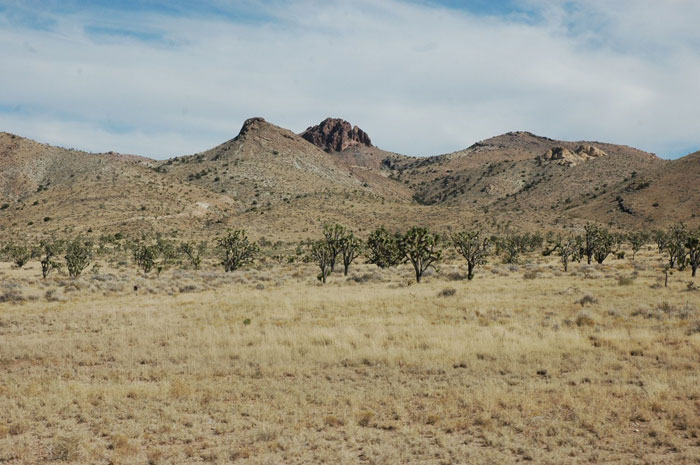
^Unique desert grassland habitat in the Castle Mountains area, but this is not Mojave Desert tortoise habitat.
March 1, 2011 - BrightSource Energy may be permitted to use a purchase of the 7,600 acre Castle Mountains Venture property as mitigation land to offset the impacts to Desert tortoises that are being caused by development of the Ivanpah Solar Electric Generating System. This property is a "keyhole" of private land in the northeastern part of Mojave National Preserve, containing both an open pit mine, but also a unique Mojave desert grassland and Joshua tree savanna. The problem lies in that this area has no tortoises; it is too high and out of their range.
Questions over finding compensatory habitat to mitigate for tortoises have arisen, and some have asked whether BrightSource or the agencies involved would be able to find adequate mitigation land to compensate for the removal of nearly 4,000 acres of high quality desert tortoise habitat located in the California region of the Northeastern Recovery Unit.
The California Department of Fish and Game is well aware that it is rare to find desert tortoise habitat that begins above 4,000 feet and the acquisition land is located in the Eastern Recovery Unit, not the genetically unique Northeastern Recovery Unit.
Of the 11 rare plant species found on the ISEGS site, only one is found overlapping in the Castle Mountains mine area. This would not mitigate the loss of the rare plants in Ivanpah Valley.
It is not scientific to assume that desert tortoises or other species will simply use this area sometime in the future as a response to climate change simply because it is located at a higher elevation. It is also very difficult to predict the exact future distribution of favorable plant species for desert tortoise. Warmer temperatures are only one factor that would be needed to insure that any species will move to a certain area. Other factors could include soil type and competing species. Will connectivity corridors surrounding the mine be managed to prevent development that would be detrimental to future long term migration? How much has this actually been evaluated?
We would like to request that the idea to use the Castle Mountains Venture as mitigation land to compensate for the impacts of the Ivanpah Solar Electric Generating System be abandoned. We would hope that a more scientific solution to this problem will be pursued. This area should be made part of the park, but should not be used as part of tortoise mitigation.
Western Watersheds Project Challenges Ivanpah Solar Project
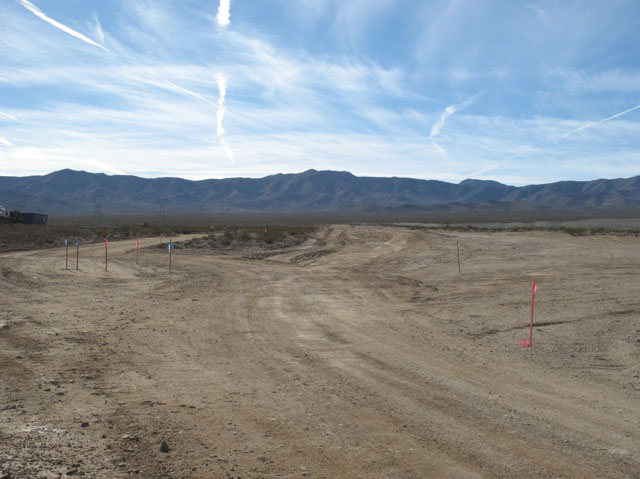
^ISEGS logistics area, January 9, 2010. (Photo Sid Silliman)
January 17, 2011 - On Friday January 14, 2011 Western Watersheds Project filed suit in federal court to halt construction of the Ivanpah Solar Electric Generating System on 5.4 square miles of high quality habitat for the threatened Desert tortoise.
“No project can be considered clean or green when it involves destruction of habitat for a species listed under Endangered Species Act on this scale,” said Dr. Michael J. Connor, California Director for Western Watersheds Project. “The Department of Interior is tasked with siting energy projects in an environmentally sound manner. Instead it is allowing thousands of acres of important desert tortoise habitat to be bulldozed when there are alternative ways of generating power” (see http://hosted.verticalresponse.com/435877/22036ba87b/1454001502/4395496dbe/).
Executive Director of WWP Jon Marvel said, "Much better places to construct these mega-projects do exist where negative impacts would be greatly reduced. Vast expanses of private agricultural lands no longer in production and already degraded could provide ample space for industrial alternative energy projects. An even more promising alternative would involved using commercial and residential rooftops for photovoltaic panels thereby giving individuals and not giant corporations the benefits from a truly green energy future. Distributive production of energy that gives individuals, not giant corporate energy interests, more say and more economic benefit in our 'green' energy future."
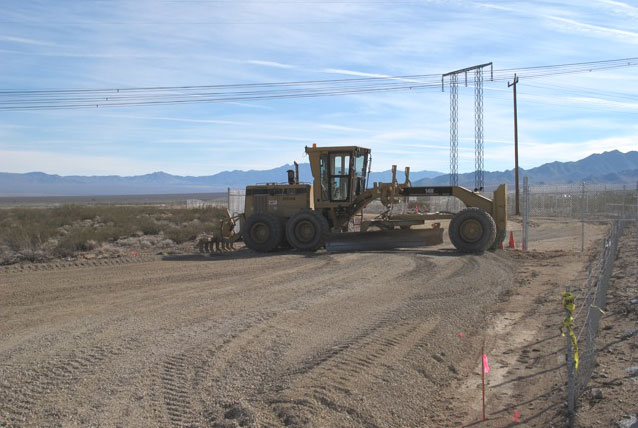
^ISEGS logistics area, January 9, 2010. (Photo Sid Silliman)
The lawsuit filed in US District Court names Interior Secretary Ken Salazar, Director of Bureau of Land Management Bob Abbey, as well as officials of the US Fish and Wildlife Service, among other agency authorities as defendants.
WWP says the project was rushed in vying for multi-billion dollar federal subsidies and violated the National Environmental Policy Act (NEPA), Federal Land Policy Management Act (FLPMA), and the Endangered Species Act.
Under National Environmental Policy Act (NEPA) violations, WWP says the Environmental Impact Statement (EIS) unlawfully segmented review of connected actions, failing to analyze the impacts of the proposed Eldorado-Ivanpah transmission upgrade, which it said was needed to carry ISEGS power and power from other renewable proposals in the area. The transmission line would cross Desert tortoise Critical Habitat, yet this was ignored.
WWP also says the agencies needed to prepare a Programmatic EIS. Agencies should have considered the group of related utility-scale solar projects and transmission lines in the California Desert that are all required to meet the state Renewable Portfolio Standard. WWP asks BLM to now prepare such a PEIS. The California desert environmental resources need to be inventoried (a start at such an endeavor was begun by the Desert Renewable Energy Conservation Plan), what renewable energy resources are needed, and then determine where the best places to put the renewable energy projects would be. Alternatives such as rooftop solar should also be analyzed.
BLM failed to define a proper Purpose and Need, according to WWP, a crucial requirement of NEPA. The purpose should not be "to make money for the solar company," but this is basically what BLM deferred to, allowing in their EIS the only purpose being to respond to the applicant. NEPA requires a Purpose and Need in the public interest to be addressed.
Importantly, BLM did not analyze feasible alternatives such as private land and Distributed Generation options. Their justification was to say these were not in their jurisdiction. But NEPA directs agencies not to refuse alternatives merely because they may require approvals or participation by others.
Numerous mitigation measures were deferred until after project approval, cutting the public out of the review process, and violating law. Examples of such deferred mitigation plans include a lack of an Avian Protection Plan to prevent the "take" (killing or harassment) of a Golden eagle by the extreme concentrated solar beams of the power tower, which would violate the Bald and Golden Eagle Protection Act. Mitigation plans for Burrowing owls, Migratory birds, Desert tortoise, Bighorn sheep, and rare plants were also deferred.
The EIS did a poor job of analyzing impacts to the Desert tortoise and groundwater resources as well, says WWP. In addition, BLM failed to recirculate the EIS after significant changes to the project were made. The public had no idea of some of the new project designs until after approval.
The Federal Land Policy Management Act (FLPMA) has standards for multiple use and sustainable yield of public lands, consider long-term benefits to the public against short-term benefits. Land use plans serve as guidance, specifically in this case the California Desert Conservation Act Plan (CDCA) with its various local amendments such as the North East Mojave Plan (NEMO).
The project is inconsistent with the CDCA Plan in that the location in the Ivanpah Valley is designated as "Multiple Use Class L" -- Limited Use -- to protect sensitive, natural, scenic, ecological, and cultural resource values. These areas are managed for lower-intensity, carefully-planned multiple uses, not a single high-intensity virtual privatization by one company.
The project is not consistent with the North East Mojave Plan in that the project will disturb more than 30 times the 100-acre allowable maximum amount of Desert tortoise habitat.
Under the Endangered Species Act, federal agencies such as BLM must consult with the US Fish and Wildlife Service (FWS) on a proposed project. FWS gives a list of potentially-occurring threatened and endangered species, and BLM prepares a Biological Assessment to determine whether such species will be affected by the action. The project must not proceed until FWS prepares a Biological Opinion to evaluate the project's impacts to such species or critical habitat. Then BLM must ensure that the project does not adversely affect the species or its habitat.
But here FWS failed to use the best available scientific data about tortoises: initial surveys failed to adequately describe the tortoise population on the site. And FWS failed to re-initiate consultation after incidental take numbers were exceeded. FWS's Biological Opinion states that if more than 38 subadult or adult tortoises were found during translocation activities (clearance surveys), the BLM must re-initiate. The agencies attempted to artificially lower the number of tortoises found, according to WWP, but even this number will be exceeded, as it claims 30 tortoises have been found, on only 32% of the project during construction. Tortoises are widely distributed in Ivanpah Valley, therefore more will plainly be found on the whole project site.
WWP asks the judge for an injunction, and for BLM to withdraw its EIS and FWS to withdraw its Biological Opinion. The suit asks that all activities on the project be stopped that would result in any changes or alteration to the physical environment until the defendants comply with law.
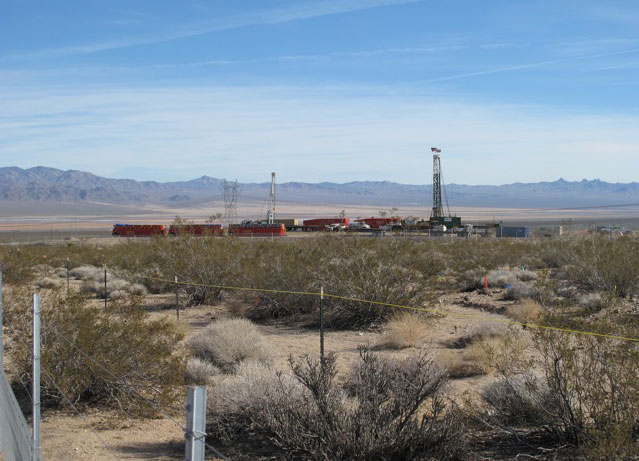
^ISEGS logistics area, January 9, 2010. (Photo Sid Silliman)
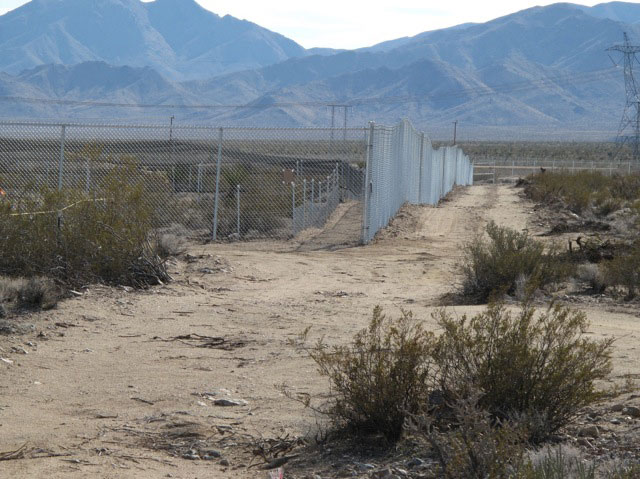
^ISEGS fence, January 9, 2010. (Photo Sid Silliman)
In related news, BrightSource Energy, the company building ISEGS, wants to purchase 7,600 acres from Castle Mountain Venture, which is restoring an open pit Hart Mine on the land, to make up for desert tortoise habitat lost to the Ivanpah development. This land-acquisition proposal is under review by the state energy commission, the BLM, California Department of Fish and Game, and U.S. Fish and Wildlife Service. This area is a "keyhole" of private land surrounded by Mojave National Preserve, a place of very rare Mojave Desert Grassland habitat with Joshua Tree savanna that conservationists have been trying to protect and add to the park for years now. The problem, however, is that this land is not tortoise habitat, lying above the elevation normal range of the reptile. U.S. Geological Survey scientist Kristin Berry, who has studied the animals since the 1970s, said tortoises are found only occasionally at elevations above 4,000 feet. The land BrightSource wants to buy ranges from 4,100 to 5,200 feet.
http://www.pe.com/localnews/stories/PE_News_Local_D_rewild16.104a1ef.html
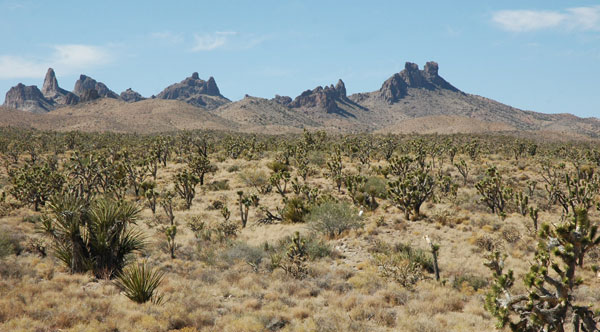
^Castle Mountains area of unique desert grassland and Joshua tree woodland. This area should be protected, but not as a mitigation land acquisition for Ivanpah Valley tortoise habitat destroyed by solar developments. It is not good tortoise habitat.
See also:
http://www.pe.com/localnews/stories/PE_News_Local_D_solarsuit20.24399b.html
http://www.sbsun.com/ci_17168039
Grading Continues
December 10, 2010 - The Construction Logistics Area has been largely graded, and new main access road, as well as perimeter road around Phase 1. These photos were taken a few days ago:
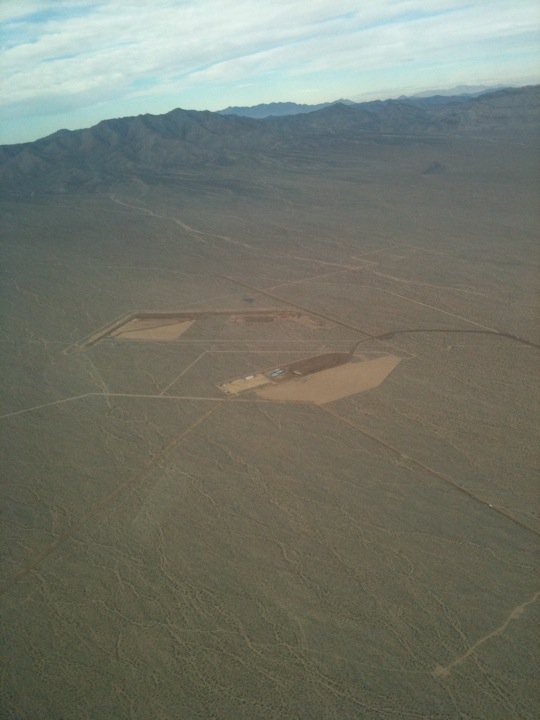
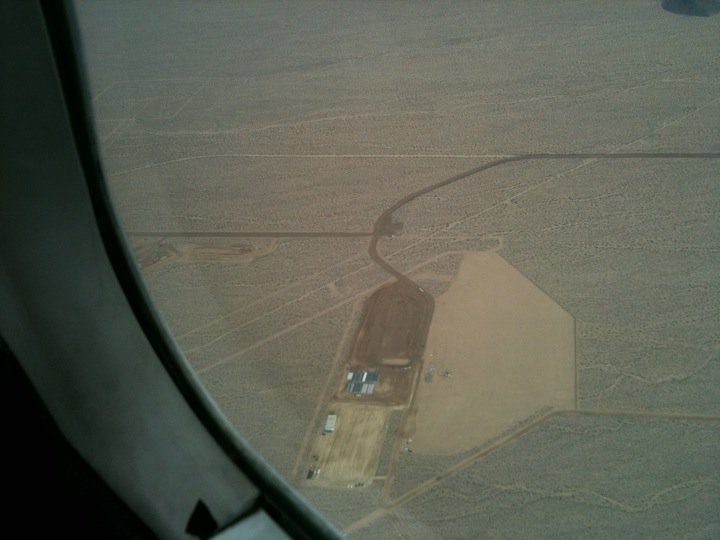
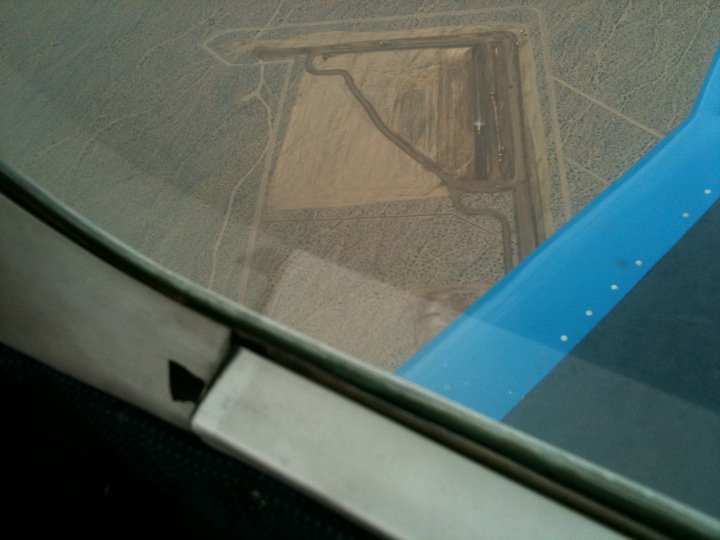
Tortoise Clearance Ended
November 10, 2010 - According to Bureau of Land Management the tortoises clearance of Phase 1 has ended and only a skeleton crew is now monitoring construction over winter.
40 tortoises were found, although the number is speculative because a couple might have been in deep burrows.
23 tortoises are considered "in" the project, 14 "out." A couple were in burrows and it was too late to dig them out, the biologists did not want to disturb them. The tortoises that were considered out were judged so because they were headed out to burrows outside the project. The tortoises considered in were said to be headed to known burrows inside the project. This too should be considered speculative, we beleive, because tortoises may wander irregularly and have multiple burrows.
9 juveniles are included in the 40 count. Some were 180 milimeters and under, some were "tiny."
All tortoises were radio-transmittered to be able to track their locations.
Mortality: 2. One run over. One predated by a coyote, the carcass was found on the Metamorphic Hill torn apart; it had roamed far, and it had been transmittered.
So according to BLM they have not reached the 38 limit that would trigger reconsultation with US Fish and Wildlife Service over the need to find more areas to move tortoises to. There is no new plan but BLM is aware that they will undoubtedly find more tortoises next spring when clearance begins again for the remaining areas of the 3,400-acre project.
November 16, 2010 New York Times article - http://www.nytimes.com/2010/11/17/business/energy-environment/17WILD.html
Latest Tortoise Count Casts Doubt on Methods
November 5, 2010 - As BRW has stated recently, wildlife officials at two agencies agreed in separate interviews that the survey methods used to evaluate sites for energy projects and other development should be improved so decision-makers can get a better handle on the land's habitat value.
Biologists hired by BrightSource found 23 tortoises in the first 2 square miles to be developed. Earlier surveys found only 16 tortoises on the entire 5.6-square-mile area approved for the solar project. The discrepancy casts doubt on the adequacy of wildlife surveys done before the project received state and federal approvals, officials said.
In addition to the 23 tortoises found in the construction area, another 18 were discovered near the project area; some were already outside the fence and others were simply moved outside when it was determined that their burrows were not in the construction zone. The roundup concluded Thursday after no additional tortoises were found.
Another two have died, one apparently killed by a coyote and the other by a light vehicle, said Larry LaPre, a U.S. Bureau of Land Management biologist.
"We need more accurate information at front end to see where these projects should be," said Dr. Kristin Berry, Riverside-based tortoise biologist with the U.S. Geological Survey. She has studied tortoises for decades and published dozens of papers on them.
"We need better surveys for better management decisions," she said. "This is public land, and the tortoises are a public resource."
Berry said potential sites should be surveyed several time
The higher the tortoise densities, the more reluctant officials will be in approving areas for development, she said.
Berry and other scientists have said that large-scale projects should first go on disturbed land, like former farms, that have little habitat value, rather than on unspoiled public land.
Ray Bransfield, a U.S. Fish and Wildlife Service biologist, said the pre-approval surveys should be more thorough. "We should look harder earlier on," he said.
The tortoises captured so far -- nine juveniles and 14 adults -- have been placed in 60-by-60-foot pens where they will spend the winter. In the spring, they will be moved to an area closer to the Clark Mountains. Each adult gets its own pen, part of an effort to prevent the spread of an upper-respiratory disease prevalent among the animals. Blood samples have been taken to test for the disease, said Mercy Vaughn, a lead contract biologist for BrightSource.
Excellent reporting by David Danelski.
http://www.pe.com/business/local/stories/PE_News_Local_D_solar05.484a297.html
Tortoise Count Rising
October 29, 2010 - The latest count is 28 tortoises on the project site, including one juvenile.
Groundbreaking Ceremony
October 27, 2010 - >>here.
More Tortoises Found Than Expected So Far at Ivanpah Project
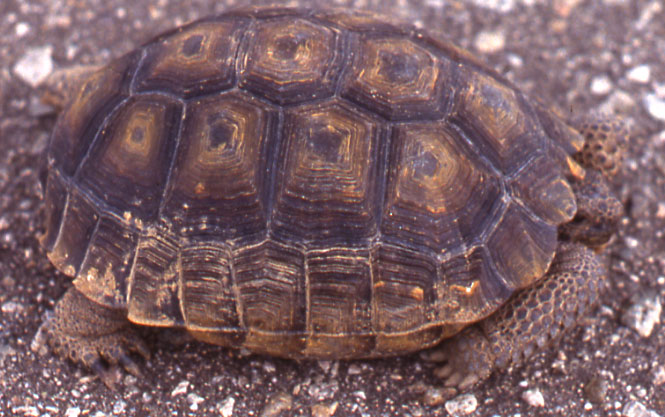
October 22, 2010 - According to Bureau of Land Management, now 17 tortoises have been found during the road-building of perimeter roads of Phase 1 and the Construction Logistics Area. Apparently these tortoises will not be considered "relocated," just re-positioned after handling and disease examiniation to the other side of the new tortoise fences being built. One of these tortoises was a juvenile, indicating the population is reproducing (some West Mojave populations and northeastern populations have apparently ceased breeding, as no juveniles are found in recent years).
BrightSource contractors started clearing desert tortoises from the fenceline surrounding the Phase 1 area of the Ivanpah Solar Project on October 6. By October 16 they had found 15 adult tortoises and were checking them for disease and holding them for relocation into the area near the project in the Ivanpah Valley.
The only problem here is that the US Fish and Wildlife's Biological Opinion for the entire three phase project only expects 32 adult tortoises to be found. A re-initiation of consultation is to take place when 38 or more tortoises are found over the entire three phase project. The 17 tortoises have been found on the perimeter of Phase 1 only, no clearance of the interior of Phase 1, no clearance of Phase 2 or 3 boundaries yet.
The table from the 10/1/2010 Biological Opinion shows the expected number of tortoise take for the whole 3 phases of the project is 32 Adults. (Click on the Biological Opinion Part 4 Take Summary Table)
Today we heard reports of a possible tortoise killed on the project site. We will try to confirm this soon.
http://www.pe.com/localnews/stories/PE_News_Local_D_solar20.294293c.html
See also this October 23 story in the Los Angeles Times: http://www.latimes.com/business/la-fi-solar-plant-20101023,0,3397425.story
BLM Issues Right-of-Way
October 14, 2010 -
[Federal Register: October 14, 2010 (Volume 75, Number 198)]
[Notices]
[Page 63198]
From the Federal Register Online via GPO Access [wais.access.gpo.gov]
[DOCID:fr14oc10-92]
-----------------------------------------------------------------------
DEPARTMENT OF THE INTERIOR
Bureau of Land Management
[CACA-48668, 49502, 49503, 49504; L51010000 FX0000 LVRWB09B2400
LLCAD09000]
Notice of Availability of the Record of Decision for the Ivanpah Solar Electric Generating System Project and Approved Plan Amendment to the California Desert Conservation Area Plan, San Bernardino County, CA
AGENCY: Bureau of Land Management, Interior.
ACTION: Notice of availability.
-----------------------------------------------------------------------
SUMMARY: The Bureau of Land Management (BLM) announces the availability of the Record of Decision (ROD)/Approved Plan Amendment (PA) to the California Desert Conservation Area (CDCA) Plan for the Ivanpah Solar Electric Generating System (ISEGS) Project located in San Bernardino County, California. The Secretary of the Interior signed the ROD on October 7, 2010 which constitutes the final decision of the Department. The ROD/Approved PA are effective immediately.
ADDRESSES: Copies of the ROD/Approved PA have been sent to affected Federal, state, and local government agencies and to other stakeholders and are available upon request at the BLM's Needles Field Office, 1303 South Highway 95, Needles, California 92363 or via the Internet at: http://www.blm.gov/ca/st/en/fo/needles/nefo_nepa.html.
FOR FURTHER INFORMATION CONTACT: Tom Hurshman, Project Manager, at 2465 South Townsend Ave., Montrose, Colorado 81401; phone: (970) 240-5345; e-mail: caisegs@blm.gov.
SUPPLEMENTARY INFORMATION: The ISEGS Project was proposed by Solar Partners I, Solar Partners II, Solar Partners IV, and Solar Partners VIII, LLC all subsidiaries of Bright Source Energy (BSE) who filed four right-of-way (ROW) applications on public land for development of the thermal solar power tower project. The Selected Alternative approved in the ROD is the Mitigated Ivanpah 3 Alternative that would generate 370 MW of electricity and would be located on approximately 3,472 acres of public land. The BLM will authorize the project through the issuance of four ROW grants pursuant to Title V of the Federal Land Policy and
Management Act. The project site is located entirely on public land administered by the BLM, approximately 4.5 miles south of Primm, Nevada in San Bernardino County, California.
The CDCA Plan Amendment/Final Environmental Impact Statement was published on August 6, 2010 (75 FR 47619), initiating a 30-day protest period and concurrent 30-day comment period. Six protests of the proposed plan amendment and 18 comments on the project were received. [Basin and Range Watch filed one of these protests] Public comments and protests did not significantly change the decisions in the ROD/Approved PA. The BLM has consulted with other Federal, State and local agencies. The California Governor's Office of Planning and Research did not identify any inconsistencies with the proposed PA and any state plans, policies or programs. Because this decision is approved by the Secretary of the Department of the Interior, it is not subject to appeal (43 CFR 4.410(a)(3)).
Authority: 40 CFR 1506.6.
Mike Pool,
Deputy Director, Bureau of Land Management.
[FR Doc. 2010-25858 Filed 10-13-10; 8:45 am]
BILLING CODE 4310-40-P
Tortoise Monitors At Work
October 8, 2010 - Ivanpah Valley, California
http://www.pe.com/localnews/stories/PE_News_Local_D_tortoise09.26f97a4.html
http://www.latimes.com/news/local/la-me-tortoise-removal-20101009,0,5440740.story
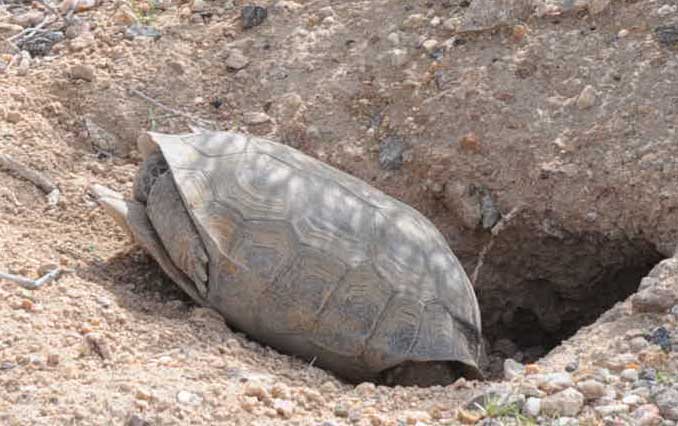
^A female tortoise emerging from her burrow hides at the sight of people. Ivanpah Valley.
Ivanpah Valley is the Heart of the East Mojave
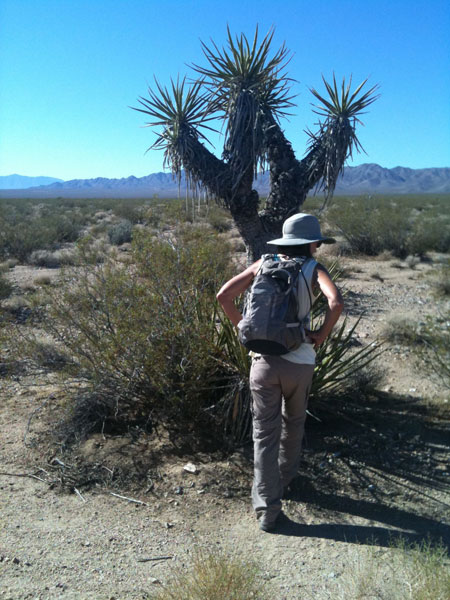
<A very tall Mojave yucca (Yucca schidigera) on the solar project site. This tree will have to be removed.
October 8, 2010 - "Rather than be smart from the start by utilizing ecologically degraded sites first, a reckless and scientifically unmerited decision has been made to instead race into our most pristine desert and obliterate some of the most botanically significant lands in California.
"The project hemorrhages the very heart of the biologically rich eastern Mojave Desert where plant diversity rivals that of the primeval coastal redwood forests of the Pacific Northwest. An area treasured by scientists throughout the world for its unparalleled pristine quality among deserts, and recognized as one of the last functional ecosystems left on planet earth.
"The project relies on mitigation concepts with no scientific foundation, and on statements of overriding consideration that sets a very low bar for how our generation chooses to transform how we generate energy while cohabiting the planet - indeed we have hastened the very ecological destruction for which the ISEGS project is meant to mitigate.
"Like much of the eastern Mojave Desert, Ivanpah Valley lies at the hub of a floristic frontier where botanists continue to discover new species to science. With as many as 10% of the plant species yet to be described, we measure the costs of destroying this desert by extinction not only to known species, but to those we will never know."
--James M. Andre
Director, Granite Mountains Desert Research Center
University of California
Recent Press articles:
http://www.sbsun.com/news/ci_16282923
http://www.desertdispatch.com/news/solar-9412-ivanpah-power.html
http://latimesblogs.latimes.com
ISEGS Approved by Salazar
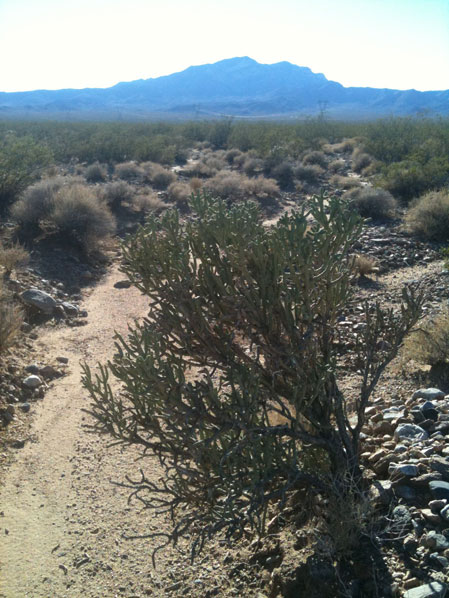
<Pencil cholla (Cylindropuntia ramosissima) on Phase 1 of the project site, with Clark Mountain in the background. The mountain is within Mojave National Preserve.
October 7, 2010 - Interior Secretary Ken Salazar signed the approval for allowing BrightSource Energy to begin constucting it's 370 megawatt solar thermal power plant on 3,471 acres of land managed by the Bureau of Land Management.
“Ivanpah is one of several renewable energy projects in the pipeline that will help California and this nation build a clean energy economy,” Secretary Salazar said in signing the Record of Decision. “With this project, we are making great strides toward meeting the President's goals for creating new jobs for American workers, reducing carbon emissions, promoting energy independence and strengthening our national security."
Through the American Recovery and Reinvestment Act, renewable energy developers whose projects begin construction by the end of 2010 can apply for payments of up to 30 percent of the eligible costs of the project. Also under the Recovery Act, BrightSource has been awarded $1.37 billion in conditional loan guarantees from the U.S. Department of Energy for this project.
The project has undergone extensive environmental review, starting with public scoping in November 2007, followed by a draft environment impact statement (EIS) and full public involvement in November 2009, and a supplemental draft EIS in April 2010. A final EIS was issued in August 2010. The Department of Interior press release says: "Salazar noted that BLM significantly altered the BrightSource proposal in response to public comments in order to minimize environmental impacts." BLM reduced the size of the project by 15 percent, from 4,073 acres down to 3,471 acres and the number of heliostats (solar mirrors) from 214,000 to 173,500.
The company must also compensate for impacts to wildlife, water, and other resources through a joint compensation fund created by Federal and State agencies and operated by the National Fish and Wildlife Foundation. To satisfy federal and state requirements, BrightSource will acquire more than 7,300 mitigation acres. Pursuant to a U.S. Fish and Wildlife Service approved plan, Desert tortoise onsite will be tested for disease, translocated to suitable, comparable habitat and monitored.
“I am pleased with the changes we have made to improve this project,” Salazar said. “It is important that we learn from our experience to ensure that environmentally-responsible clean energy is developed wisely and in the right places.”
Tomorrow tortoise biologists will begin placing tortoise-exclusion fence around the first phases of the project so that the repriles can be dug out of their burrows and moved to west and north of the project site.
Ivanpah Valley Project Site Mapped as "Ecologically Core"
October 4, 2010 - The Nature Conservancy released its Mojave Desert Ecoregional Assessment, and it is good. The report discusses the impacts of large-scale solar projects on desert lands.
The ISEGS project site in northwestern Ivanpah Valley in California is mapped as:
Ecologically Core:
"These lands have the highest conservation value. They are largely undisturbed and unfragmented, support conservation targets (species, ecological systems, springs and seeps), and were identified as critical to fully protect for the long-term conservation of the ecoregion’s biological diversity. Despite the high inherent value of Ecologically Core lands, they do not stand alone; their conservation value is highly dependent on the connections between them and the buffering that the Ecologically Intact and even some of the Moderately Degraded lands around them provide. If significant portions of surrounding Ecologically Intact and Moderately Degraded lands are disturbed, developed, or otherwise compromised or further degraded in the future, then the conservation value of nearby Ecologically Core lands will diminish as well."
Mojave Desert Ecoregional Assessment, September 2010, The Nature Conservancy of California 201 Mission Street, 4th Floor San Francisco, CA 94105.
http://conserveonline.org/workspaces/mojave/documents/mojave-desert-ecoregional-2010/@@view.html
California Energy Commission Licenses ISEGS

<Clark Mountain receives the morning sun on the Ivanpah solar project site.
September 22, 2010 - During a business meeting attended by the full compliment of five Commissioners, taking 90 minutes for comment and discussion, the vote was unanimously positive to approve the Ivanpah Solar Electric Generating System. CEO of BrightSource, John Woolard, was allowed to speak first, thanked the CEC, this will be a great project, will create a thousand jobs, and will help the state meet its Renewable Portfolio Standard goals.
"This project presented us with significant environmental challenges," said Energy Commissioner Jeffrey Byron. "However, the applicant's changes to the original proposal and the constructive input of a record number of participants mean the Ivanpah project will now produce renewable energy and provide needed economic activity to the region while minimizing the impact to the desert's natural environment."
BrightSource Energy, Inc. of Oakland would develop three solar thermal power plants and shared facilities in the Mojave Desert west of Ivanpah Dry Lake and 4.5 miles southwest of Primm, Nevada. The project would be located on 3,582 acres of public land managed by BLM. The project's footprint was reduced by 12 percent from 4,073 acres to 3,582 acres "to lessen the impact to biological resources."
The project would be constructed in three phases: one 120-MW phase and two 125-MW phases and is based on distributed power tower and heliostat mirror technology, in which heliostat (mirror) fields focus solar energy on tower receivers near the center of each heliostat array to generate steam-driven electricity. Before construction, biological monitors will build a fence around parts of the project site and erect an exclusion fence, to begin removing tortoises. To date, the Final Desert Tortoise Translocation Plan has not been released for public review, nor have the locations for placing the tortoises been completely determined. The applicant at first said that many tortoises would be moved to holding pens within Mojave National Preserve in southern Ivanpah Valley, but the National Park Service disagreed with this plan and vetoed it recently.
According to the CEC press release, "The PMPD for the Ivanpah Solar Electric Generating System project said the facility, even with mitigation measures, will have significant impacts on biological resources, land use, traffic and transportation, transmission systems engineering, and visual resources. However, the benefits of the project would override those impacts."
Intervenors Center for Biological Diversity, California Native Plant Society, Western Watersheds Project, and Basin and Range Watch also gave their comments on the high value of the site for wildlife connectivity, tortoise, and new scientific finds about rare plants. Defenders of Wildlife made of no comment.
But the feel of the meeting was more of a congratulation session and back patting for the approval by the Energy Commission towards BrightSource.
Despite the 90 public comments that were received for the Presiding Member's Proposed Decision vote, little discussion ensued. Comments seemed to have little sway.
Lloyd Gunn of the Society for the Conservation of Bighorn Sheep made a very good public comment by telephone describing how he had just visited the site in beautiful Ivanpah Valley, and seen the amazing geoglyph held sacred by local Native American Tribes.
The solar project cannot yet begin construction, as it needs the permit to be able to build on public land. The Bureau of Land Management will issue its Right of Way decision in October.
A collection of articles:
BrightSource secures solar farm approval, eyes IPO opportunity: Reports claim IPO is on the cards for next year, as California green lights plans for desert solar farm - http://www.businessgreen.com/business-green/news/2270286/brightsource-secures-solar-farm
BrightSource Energy Appoints John E. Bryson as Board Chairman: Former chairman and CEO of Edison International [and co-founder of National Resources Defense Council, and on the Board of Walt Disney] to lead BrightSource board - http://www.marketwatch.com/story/brightsource-energy-appoints-john-e-bryson-as-board-chairman-2010-09-21?reflink=MW_news_stmp
BrightSource's Ivanpah solar project approved by California Energy Commission - http://latimesblogs.latimes.com/greenspace/2010/09/brightsource-ivanpah-solar-project-approved-by-energy-commission.html
Solar project could create 1,000-plus construction jobs - http://www.vvdailypress.com/news/jobs-21918-project-brightsource.html
State OKs Ivanpah solar project construction: BLM to make decision next month - http://www.desertdispatch.com/news/project-9304-energy-construction.html
California Energy Commission approves BrightSource Energy's plans to build a 370-megawatt solar thermal power plant in the Mojave Desert - http://www.contracostatimes.com/business/ci_16146520?source=rss&nclick_check=1
California Energy Commission Licenses BrightSource Energy's Ivanpah Solar Electric Generating System: California Grants Key Approval, Requires Only Federal Approval to Begin Construction - http://finance.yahoo.com/news/California-Energy-Commission-bw-1137699024.html?x=0&.v=1
MOJAVE DESERT: Feds lay out tortoise relocation rules - http://www.pe.com/localnews/stories/PE_News_Local_D_tortoises25.3137fa6.html
Mohave and Chemehuevi Discuss Sacred Site at Ivanpah
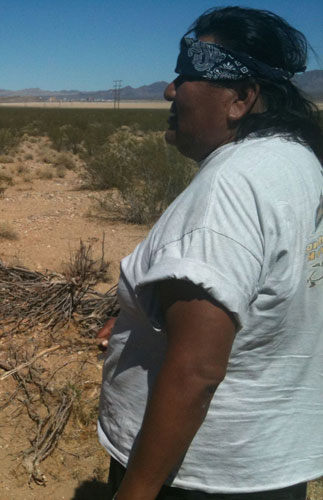
September 15, 2010 - At a camping trip to Ivanpah Valley, representatives from the Chemehuevi and Mohave Tribes came to protest the potential disturbance of the desert and a sacred hill by the massive 3,600-acre Ivanpah Solar Electric Generating System that would lie across much of the fan and only a few hundred yards from a strange geoglyph on top of a small hill.
Ron Van Fleet (>right) of the Mohave Tribe from Colorado Valley, Arizona, explained to those gathered how the geoglyph represented the Creation story to him, and how as protectors of the desert, they needed to include this place in their efforts to stop large-scale solar power projects from destroying cultural resources.
They were also quite concerned with the 1,000-megawatt Blythe Solar Power Project which will wipe out hundreds of geoglyphs and cultural sites.
Van Fleet told us that all of the desert is important and should be conserved, not just the project site. Moving it down the valley would not work. "They did not ask us if they could build this here," Van Fleet said. He explained that even the Spaniards and overland explorers would ask the Tribes permission to cross their land and use their water sources and hunt the animals. Now the Tribes feel they are being ignored by the Bureau of Land Management and Energy Commission.
See the Las Vegas Review Journal story http://www.lvrj.com/news/tribes-join-protests-of-ivanpah-solar-project-102926439.html
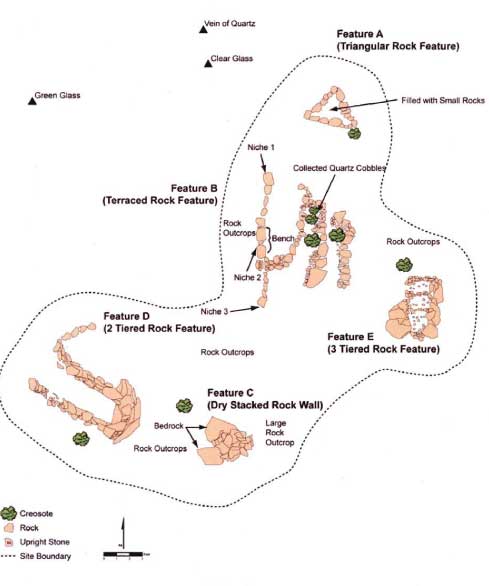
^Geoglyph next to the solar project site. Archaeologists could not decide what the significance of this feature was, but the Chemehuevi and Mohave say it is part of a sacred hill that is part of a regionally important cultural area.
Energy Commission to Provide Grant to Study Ivanpah Tortoises
September 8, 2010 - The California Energy Commission awarded $238,310 to the University of California at Davis for research techniques to increase the survival of young desert tortoises. Funds for the two research projects come from the Commission's Public Interest Energy Research (PIER) program.
"The project will help mitigate renewable energy projects in California deserts."
The research will evaluate the effectiveness of "headstarting" and jumpstarting juvenile desert tortoises as innovative mitigation and recovery tools. Headstarting calls for maintaining eggs and juveniles in semi-natural enclosures for a period of time to protect them from predators. Jump-starting will use rain supplementation to mimic natural rainfall in non-drought years to increase
the food supply. That could potentially double the growth rate of hatchling tortoises, according to the project proposal. As part of the project, UC Davis is providing $46,150 in the form of in-kind
services. The National Park Service's Mojave National Preserve is constructing and operating the new Ivanpah Desert Tortoise Research Facility, where the research will be conducted. The University of Georgia's Savannah River Ecology Laboratory is contributing the use of equipment.
http://www.energy.ca.gov/releases/2010_releases/2010-09-08_awards_research_projects.html
http://www.energy.ca.gov/research/
Public Review?
August 27, 2010 - "Within 60 days of publication of the Energy Commission Decision the project owner shall provide BLM’s Authorized Officer and the CPM with the final version of a Desert Tortoise Relocation/Translocation Plan that has been reviewed and approved by BLM, USFWS, and the CPM in consultation with CDFG. BLM’s Authorized Officer and the CPM will determine the plan’s acceptability within 15 days of receipt of the final plan. All modifications to the approved translocation must be made only after consultation with BLM’s Authorized Officer, USFWS and the CPM, in consultation with CDFG.
"Within 30 days after initiation of translocation activities, the Designated Biologist shall provide to BLM’s Authorized Officer and the CPM for review and approval, a written report identifying which items of the Plan have been completed, and a summary of all modifications to measures made during implementation of the Plan."
(August 27, 2010 letter: Clerical Errors In PMPD Condition Language for the Ivanpah Solar Electric Generating System, 07-AFC-5, California Energy Commission)
At present, only a Draft Tortoise Translocation Plan is available. The Final plan will apparently come out after the approval of the project.
Tortoise Translocation
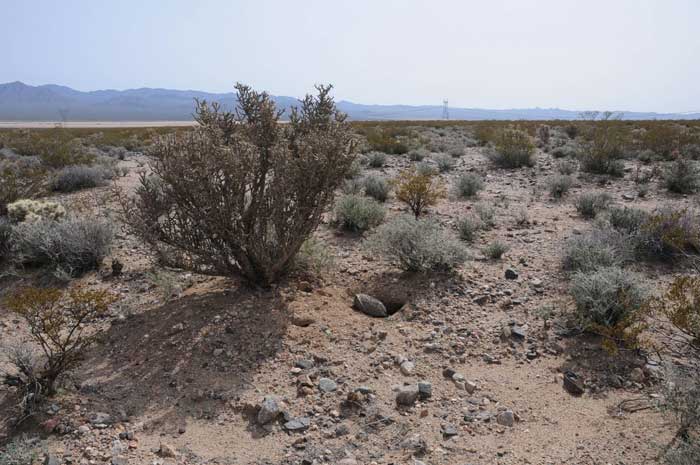
August 25, 2010 - The California Energy Commission held its evidentiary hearing for review of the Presiding Members Proposed Decision on the Ivanpah project on August 24, 2010 in Sacramento. The issue of what to do with tortoises dominated the proceeding.
Center for Biological Diversity, an intervenor in the case, told CEC they must fulfill their duties under the California Environmental Quality Act and California Endangered Species Act if it will issue a permit (under the authority of California Department of Fish and Game) for "take" of tortoise.
The whole translocation plan for tortoises is in draft form, and is not even available for public review in part. New guidance from US Fish and Wildlife Service says "relocation" is under 500 meters, and "translocation" is over 500 m, but this is only to inform decisions about testing for disease (blood samples drawn to test for Upper Respiratory Tract Syndrome). But the differences is meaningless to the tortoise. Whenever you move a tortoise into an area with a resident population of tortoises already present, there is the potential for agonistic behavior (aggression) on the part of the residents when a newcomer invades it home range. This often causes the newcomer to move away long distances.
Currently some of the tortoises would be relocated short-distance to the west and north of the project "out of harm's way" yet these very areas are also slated for solar developments and two high-speed train routes. This will not guarantee tortoises are safe in the future.
Mojave National Preserve has not yet agreed to be the recipient site for long-distance translocated tortoises, but if this option is chosen, full separate NEPA review should be undertaken for this action. This part of the preserve in southern Ivanpah Valley is critical habitat for the Federally Threatened tortoise, designated a Desert Wildlife Management Area.
No translocation or relocation of any kind should be done, as it is problematic and tortoises are in decline rangewide. Documents obtained by Freedom of Information Act from agencies involved in the Fort Irwin Expansion tortoise translocation show that the effort there failed. Tortoises were moved staring in March 2008, to December 2009: 44.3% died and 17.4 % are missing. This happened mostly from coyote predation. Coyotes are present also in the Ivanpah project site. Translocation may do more harm than good, as it can spread diseases into the host population. Disease testing does not always work, and not all diseases are tested for. The August 2010 Draft Independent Science Advisors Report for the Desert Renewable Energy Conservation Plan recommends against translocation/relocation of tortoises.
During the hearing no plans to fence Interstate 15 were made, to keep these wandering tortoises from going on the highway, and BrightSource should at least be made to pay for this.
The Ivanpah Valley is within the Northeastern Recovery Unit, which has tortoises with very unique genetic make-up. It is imperative that any mitigation land acquired by the applicant for the loss of tortoise habitat be kept within this northeastern Mojave Desert area, not across the desert as CEC has allowed.
Jeff Harris, attorney for BrightSource Energy, the company applying for the permits to build on the site, argued that the amount of money required by the Energy Commission to purchase land to mitigate for the loss of tortoise habitat was unrealistic for them. The SB34 bill that had passed set aside $10 million into a mitigation bank, ready for lands to be acquired as part of statewide solar development. Yet this was already not enough, BrightSource said. At current land prices in the area, that amount would buy 10,000 acres. For most projects this is the size of mitigation lands that need to be acquired in the California desert. CEC was asking for $25 million in cash for tortoise mitigation, with no cap. Counting long-term management and other mitigation costs, the total was more like $37 million cash. Harris told the committee that they needed to work out a security form, say 10% down, otherwise the "project would be dead."
The Energy Commission told Harris they were still working out the details, such as in workshops for the Calico Solar Project. Harris said they would suggest a number that would not "kill" the project. Karen Holmes, CEC attorney, told Harris that they needed enough to assure mitigation was carried out. Harris asked if CEC had the power to shut the project down if they were not complying with mitigation requirements. Holmes told him that the damage would already have been done.
Harris said they simply could not come up with this amount of cash prior to financing the project. CEC is requiring $350,000 for funding a regional raven management plan, in addition to controlling ravens on the project site. Harris seemed exasperated at the mounting costs. "So we have to do everything and pay a fee?"
Our Comments on the Energy Commission Preliminary Decision
August 20, 2010 - Basin and Range Watch Comments on the Presiding Members Proposed Decision for Ivanpah Solar Electric Generating System:
Deferred Planning: We are concerned about several "deferred plans" that were not analyzed under NEPA/CEQA, but will be done by the applicant after approval. So far we have found these:
1. Risk Management Plan for Hazardous Waste
2. Drainage Erosion and Sedimentation Plan
3. Heliostat Depth Testing Plan for mounting poles in the ground
4. Special-Status Plant Protection and Monitoring Plan
5. Special-Status Plant Remedial Action Plan (in case 4 fails)
6. Seed Collection Plan
7. Final Desert Tortoise Relocation/Translocation Plan
8. Final Raven Management Plan
9. Final Weed Management Plan
10. Revised Closure, Revegetation and Rehabilitation Plan
11. Maps of Vegetation Clearing/Mowing
12. Maps of Rare Plants On-site and Off-site
13. Identification of Desert tortoise, Nested Species, Rare Plant, and Ephemeral Drainage compensatory mitigation lands
14. Succulent Inventory for Salvage and Transplant
15. Gas Pipeline Revegetation and Monitoring Plan
16. Off-site Drainage Enhancement and Management Plan
17. Pre-construction Surveys of Vegetation Types to Guide Restoration (p. 84)
18. Vegetation Restoration Monitoring Plan
19. Soil Baseline Characterization to guide soil preparation for seed planting
20. Biological Soil Crust Restoration Plan
Several of these plans could have impacts to groundwater, yet will apparently be done later, without public review.
Soil and Water Resources: Our initial comments on the PMPD, is that it seems to have been written a long time ago, and not updated very well, as it says in a footnote that the amount of soil that will be cut and moved in Ivanpah Phase 3 is based on the Draft EIS/Final Staff Assessment, and not the updated "Mitigated Ivanpah 3" alternative which was adopted. The footprint was reduced by 430 acres, and BrightSource decided to pull out of a very large wash, "due [to] the presence of large boulders..." This buried boulder problem was never addressed in any CEC document. Thus how surface runoff, rainwater drainage, and potential groundwater impacts may not be completely addressed. We would like to make sure the entire PMPD reflects the final alternative.
We also notice a new estimate of 16,000 gallons per night of groundwater use for mirror washing, where each mirror would be washed once in a two-week rotation. This was difficult information to get, and thus indicates trucks will be spray-washing every night of the year in a giant rotation. The applicant claims wash-water will evaporate before it hits the ground, but on cold winter nights we think there could be substantial wetting of the soil. A discrepancy occurs in the PMPD, where in the Biological Resources section, it is stated that there will be a mirror-washing drip line to the ground, causing potential erosion and weed growth. This is not analyzed well.
The whole stormwater/drainage issue was never analyzed, and its affects on groundwater infiltration from changes in washes, compaction, disturbance of biological soil crusts, and increased downhill sedimentation. The Low Impact Design will still result in soil compaction, edge disturbance to ecological systems, and fragmentation. Using “low impact tires and tracks” will not stop this.
We note that the PMPD admits there will be a "failure rate" of 32,000 heliostats during a 100-year flood event. That was never discussed to our knowledge, and could be a big impact on downstream tortoise habitat. Three-dimensional scour around heliostat poles was not studied.
Biological Resources: Golden eagles were detected on the project site, yet we have not seen a report on the amount of foraging habitat or nest surveys within a 10-mile radius of the site.
Burrowing owls should be passively removed, nit actively removed from burrows during pre-construction guidelines.
Bighorn sheep studies indicate a decline in the Clark Mountains in 1991-1993 due to poor recruitment. This needs more study to determine the possible reasons, and whether the project will lead to further declines.
There is no assessment of power tower impacts to bats and birds. Is this a migration corridor?
Desert tortoise habitat on the project site is described as “high quality.” Land acquisition for mitigation should therefore be purchased at a 5:1 ratio, rather than 3:1, following California Department of Fish and Game recommendations for the Calico Solar Project (CEC Evidentiary Hearing, August 18, 2010).
There continues to be no discussion of the genetic uniqueness of the Northeastern population of Desert tortoise, and the cumulative impacts to this population in Ivanpah Valley. Conservation of the Northeastern Mojave Recovery Unit is being ignored. Biological science is advancing in its understanding of the importance of maintaining the diversity and connectivity of genetic populations, yet siting of large-scale renewable energy projects is occurring too quickly to take this into consideration.
Tortoise compensatory mitigation for habitat loss and potential take is at a 3:1 ratio, or 8,146 acres, at least two-thirds by habitat mitigation. Where will this land be found, and is it even feasible to find this acreage in the Northeastern Mojave Recovery Unit?
The DRECP Independent Science Advisors state “…the advisors do not recommend translocation of desert tortoise as effective mitigation or conservation action, in part because translocated tortoises suffer high mortality rates.” (Public Review Draft, Recommendations of Independent Science Advisors for The California Desert Renewable Energy Conservation Plan (DRECP), Prepared For Renewable Energy Action Team: California Department of Fish & Game, U.S. Fish & Wildlife Service, U.S. Bureau of Land Management, and California Energy Commission, Prepared By The DRECP Independent Science Advisors, August 2010, page 77).
Concerning brush mowing in a natural Mojave Desert scrub community, the PMPD states that the “evidence is uncertain about the effects of this mowing.” Studies should be carried out in a scientific manner before approval of the project, as mowing will have great impacts to this large area of habitat and future possibilities of restoration. How many times will vegetation need to be mowed? Mojave Desert vegetation is not adapted to this, and perennial plants may likely die off.
We believe that creating “protected habitat areas left free of project development” for the six special-status plant species is not acceptable mitigation. Staff admits this is an uncertain technique, but the known negative impacts of edge disturbance and fragmentation are well documented in the scientific literature.
Concerning revegetation and restoration of the site, the DRECP Independent Science Advisors say:
“Every effort should be made to avoid and minimize any new disturbance of soil surfaces in the siting, design, construction, and maintenance of any and all project features. Arid ecosystems are strongly shaped by characteristics of soils and other geological surfaces that develop over millennia and that cannot be replicated by human actions. Therefore, ecological impacts of projects that alter surficial geology should be presumed permanent, despite any good intentions or promises to decommission renewable energy projects at the end of their useful life and restore what came before. This does not mean that well- conceived efforts to decommission, restore, and revegetate have no ecological value, however—only that such actions can never be assumed to replicate original nature, and therefore cannot be considered full mitigation for the original impact.” (page 3)
The DRECP Independent Science Advisors also recommend preserving and protecting the Creosote bush-white bur sage scrub (Larrea tridentata-Ambrosia dumosa Alliance) supporting big galleta (Pleuraphis rigida) or a diverse shrub layer (page 13 ff.), which is present over a wide area of the ISEGS project site.
Concerning biological soil crusts, which we have seen to be abundant on the Ivanpah project site, the DRECP Science advisors recommend: “Removal or disruption of biological soil crusts can increase dust production. It can also limit primary production, especially of desert annuals, an important food source for many desert animals. Siting of developments should avoid disruption of biological soil crusts, which may require millennia to recover…” Such soil crusts should be mapped. (page 35)
In addition, all vegetation types, wildlife linkages, Audubon Important Bird Areas, Nitrogen deposition maps, desert pavement, alluvial fans, and riparian channels/washes should be mapped.
The Ivanpah Valley should be analyzed as to what habitat may be predicted to be essential to accommodate distributional shifts, in response to climate change, as predicted based on existing or future models.
The DRECP Independent Science Advisors recommend these birds for management consideration, and we have seen all these species on the ISGES project site Mojave Desert Scrub fan or in the adjacent Clark Mountain foothills. “The following bird species were selected by CalPIF (2009) as desert focal species because they use desert vegetation as their primary breeding habitat, they are great enough in abundance to provide adequate sample sizes for statistical comparisons, and they have experienced reductions from their historical breeding range. They should therefore be considered as potential planning species for DRECP.
␣ Costa’s hummingbird (Calypte costae).
␣ Ladder-backed woodpecker (Picoides scalaris).
␣ Ash-throated flycatcher (Myiarchus cinerascens). Although this species is common and widespread, it is an obligate cavity nester and therefore can serves as a surrogate for assessing nest site availability for desert cavity-nesting species.
␣ Verdin (Auriparus flaviceps).
␣ Black-tailed gnatcatcher (Polioptila melanura).
␣ Le Conte’s thrasher (Toxostoma lecontei).
␣ Crissal thrasher (Toxostoma crissale). This species is of interest because it occupies two very different desert woodland types – mesquite and riparian in the lower deserts, and pinyon-juniper woodland in the higher areas of the eastern Mojave Desert.
␣ Phainopepla (Phainopepla nitens). Phainopeplas provide important ecological services (dispersal of mistletoe seeds).
␣ Black-throated sparrow (Amphispiza bilineata).
␣ Scott’s oriole (Icterus parisorum). This is a focal species in the analysis of desert woodlands (Joshua tree and pinyon-juniper).” (page 33)
Alternatives: If the “no Project” alternative is chosen, the PMPD says that it will be likely that additional gas-fired power plants would be built. But because ISEGS will be intermittent, additional back-up power plants and baseload will need to be built anyway.
Before the Distributed Generation model is eliminated, a thorough study should be undertaken to compare Germany’s fast implementation model with the slow and inefficient California model of rooftop PV installation. Why is Germany installing thousands of MW of rooftop generation per quarter and California cannot seem to?
ISEGS Simulation
August 19, 2010 - What will the project look like next to Mojave National Preserve and Clark Mountain?
Flash Floods
August 18, 2010 - The National Weather Service in Las Vegas, Nevada, issued a Flash Flood Warning at 1:44 PM, for Ivanpah Valley in northeastern San Bernardino County. At 1:37 PM Doppler radar picked up very heavy rain from a stationary thunderstorm 10 miles southeast of Nipton. Over 3 inches of rainfall were estimated from this storm in a short period. The Service issued this warning:
IN DESERT TERRAIN THERE ARE HUNDREDS OF LOW WATER CROSSINGS WHICH ARE
POTENTIALLY DANGEROUS IN HEAVY RAIN. DO NOT ATTEMPT TO TRAVEL ACROSS
FLOODED ROADS. TURN AROUND...DONT DROWN. FIND ALTERNATE ROUTES.
We wonder what would happen to solar panels and heliostats proposed to be placed in these washes nearby at Silver State and the Ivanpah Solar Electric Generating System projects.
Heliostat Pole Failure Rate in Floods
August 13, 2010 - "While neighboring properties will not be substantially affected by increased peak or sediment flows, the data suggests that a significant number of heliostats may fail due to erosion removing the soil support for their mounting poles, as many as 32,000 during a 100-year flood event."
--From the California Energy Commission Presiding Member's Proposed Decision on Ivanpah Solar Electric Generating System, August 2010, B. Soil and Water Resources page 11.
There will be an estimated 173,500 heliostats on the site, each with two mirrors 10 feet wide (total 20 feet), and the heliostat would be 12 feet high. Amazingly, the California Energy Commission will only require study and testing later, after approval, to determine the optimum depth for the mounting poles so as to avoid erosion caused failure of the heliostats.
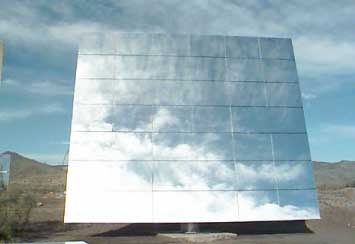
<A heliostat type from Almena, Spain.
BLM's Final Environmental Impact Statement Out
August 6, 2010 - In the Federal Register: Notice of Availability of the Proposed California Desert
Conservation Area Plan Amendment and Final Environmental Impact Statement for the Ivanpah Solar Electric Generating System, San Bernardino County, California, by the Bureau of Land Management, Interior.
SUMMARY: In accordance with the National Environmental Policy Act of 1969, as amended (NEPA), and the Federal Land Policy and Management Act of 1976, as amended (FLPMA), the Bureau of Land Management (BLM) has prepared a proposed California Desert Conservation Area (CDCA) Plan Amendment/Final Environmental Impact Statement (EIS) for the Ivanpah
Solar Electric Generating System (ISEGS) Project and by this notice is announcing its availability.
DATES: The publication of the Environmental Protection Agency's (EPA) Notice of Availability of this Final EIS in the Federal Register initiates a 30-day public comment period (see "ADDRESSES'' section). In addition, the BLM planning regulations state that any person who
meets the conditions as described in the regulations may protest the BLM's proposed CDCA Plan Amendment. A person who meets the conditions and files a protest must file the protest within 30 days of the date that the EPA publishes its notice of availability in the Federal Register (see "ADDRESSES'' section).
ADDRESSES: Please submit comments on the Final EIS to Tom Hurshman, Project Manager, telephone (970) 240-5345; address: Bureau of Land Management, 2465 South Townsend Avenue, Montrose, Colorado 81401 or by e-mail: caisegs@blm.gov. Copies of the proposed CDCA Plan Amendment/Final EIS are available for public inspection at the Needles Field
Office, 1303 South Highway 95, Needles, California 92363. Interested persons may also review the CDCA Plan Amendment/Final EIS at the following Web site: http://www.blm.gov/ca/st/en/fo/needles/nefo_nepa.html. All protests of the proposed CDCA Plan Amendment must be in writing and mailed to one of the following addresses:
Regular Mail: BLM Director (210), Attention: Brenda Williams, P.O. Box 66538, Washington, DC 20035.
Overnight Mail: BLM Director (210), Attention: Brenda Williams, 1620 L Street, N.W., Suite 1075, Washington, DC 20036.
FOR FURTHER INFORMATION CONTACT: Tom Hurshman, Project Manager, telephone (970) 240-5345; address Bureau of Land Management, 2465 South Townsend Avenue, Montrose, Colorado 81401; e-mail: caisegs@blm.gov.
SUPPLEMENTARY INFORMATION: BrightSource Energy (BSE) has filed right-of-way (ROW) applications on public land for development of the proposed ISEGS concentrated thermal solar power project that would generate up to 400 megawatts of renewable electricity through the use of 214,000 heliostats. The proposed project would be located on 4,073 acres of public land 4.5 miles south of Primm, Nevada in San Bernardino County, California. The BLM purpose and need for the ISEGS project EIS is to respond to the application under Title V of the FLPMA (43 U.S.C. 1761) for a ROW grant to construct, operate, maintain, and decommission a concentrated solar electric generation plant and associated infrastructure on public land in compliance with FLPMA, the BLM regulations, and other applicable Federal laws. The BLM will decide to approve, approve with modifications, or deny ROW applications filed by Solar Partners I, LLC; Solar Partners II, LLC; Solar Partners IV, LLC; and Solar Partners VIII, LLC, which are subsidiaries of BSE, to develop the ISEGS project. The CDCA Plan (1980, as amended), while recognizing the potential compatibility of solar power generation facilities on public lands,
requires that all sites associated with power generation or transmission not identified in that plan be considered through the plan amendment process. If the BLM decides to grant a ROW, the BLM would also amend the CDCA Plan as required.
The proposed action in the CDCA Plan Amendment/Final EIS is to authorize the ISEGS project and approve the plan amendment in response to the applications received from BSE. The BLM's Preferred alternative is Mitigated Ivanpah 3. The preferred alternative reduces the capacity
of the project to 370 megawatts, reduces the number of heliostats to 173,000, and reduces the site disturbance to 3,640 acres in order to reduce impacts to sensitive plant and animal species. In addition to the proposed action and the preferred alternative, the BLM has analyzed
an alternative that would relocate a portion of the proposed action closer to the Interstate 15 corridor (Modified I-15 Alternative). As required under NEPA, the CDCA Plan Amendment/Final EIS analyzes a no action alternative that would not require a plan amendment. The BLM has
taken into consideration the provisions of the Energy Policy Act of 2005 (EPAct 05) and Secretarial Orders 3283 Enhancing Renewable Energy Development on the Public Lands and 3285A1 Renewable Energy Development by the Department of the Interior in responding to the ISEGS applications.
The applicant has applied to the Department of Energy (DOE) for a loan guarantee under Title XVII of EPAct 05, as amended by Section 406 of the American Recovery and Reinvestment Act of 2009, Pub. L. 111-5. The DOE is a cooperating agency in the preparation of the CDCA Plan
Amendment/Final EIS. The BLM published a Notice of Availability of the Draft Ivanpah Solar Electric Generation System EIS and the Draft CDCA Plan Amendment in the Federal Register on November 10, 2009 (74 FR 58043). The Draft EIS was available for a 90-day public comment period which closed on February 11, 2010. Subsequent to the Draft EIS, the BLM
published a Notice of Availability of the Supplemental Draft EIS for the Ivanpah Solar Electric Generation System Project in the Federal Register on April 16, 2010 (75 FR 19992), to evaluate the environmental impacts of two additional alternatives. The public comment period on
the Supplemental Draft EIS closed on June 1, 2010. Comments received on the Draft EIS and the Supplemental Draft EIS are addressed in the CDCA Plan Amendment/Final EIS. Wilderness characteristics are addressed and analyzed in the CDCA Plan Amendment/Final EIS.
Instructions for filing a protest with the Director of the BLM regarding the proposed CDCA Plan Amendment may be found in the "Dear Reader Letter'' of the CDCA Plan Amendment/Final EIS and at 43 CFR 1610.5-2. E-mailed and faxed protests will not be accepted as valid protests unless the protesting party also provides the original letter by either regular or overnight mail postmarked by the close of the protest period. Under these conditions, the BLM will consider the e-mailed or faxed protest as an advance copy and it will receive full consideration. If you wish to provide the BLM with such advance notification, please direct faxed protests to the attention of the BLM protest coordinator at 202-912-7212, and e-mails to Brenda--Hudgens Williams@blm.gov. All protests, including the follow-up letter to e-mails or faxes, must be in writing and mailed to the appropriate address, as set forth in the ADDRESSES section above.
Before including your phone number, e-mail address, or other personal identifying information in your protest, you should be aware that your entire protest--including your personal identifying
information--may be made publicly available at any time. While you can ask us in your protest to withhold your personal identifying information from public review, we cannot guarantee that we will be able to do so.
Thomas Pogacnik,
Deputy State Director, Natural Resources.
California Energy Commission Preliminary Decision Out: Approve
August 3, 2010 - The California Energy Commission issued its Presiding Member's Proposed Decision (PMPD) on the Ivanpah Solar Electric Generating System. The long document details the two Commissioner's rationale for approving the project after hearing many hours and days of testimony by both the applicant BrightSource Energy, staff analysts, agencies, and intervenors (including Basin and Range Watch). There is a 30 day comment period and then the full five Commissioners at the Energy Commission convene a PMPD hearing (we have been told that they almost always vote following the two presiding Commissioners). A protest period follows. Public comments are accepted until September 2, 2010.
The Presiding Member's Proposed Decision contains the Presiding Member's recommendation on whether the application should be approved. The PMPD is a draft document, and is released for public comment. The Presiding Member may schedule a conference or hearing to take oral comments on the Presiding Member's Proposed Decision. New or additional evidence, however, will not be considered unless due process requires or the Energy Commission adopts a motion to reopen the hearing record. Thus comments from intervenors or the public should address material discussed in the proposed decision.
After the conclusion of the comment period on the Presiding Member's Proposed Decision, the Presiding Member, in consultation with the other committee member, may prepare a revised proposed decision on the application. The revised proposed decision is forwarded to the full Energy Commission and distributed to all parties, interested agencies, and any person who requests a copy for a minimum 15-day comment period.
The full Energy Commission will conduct a hearing to consider and vote on the Proposed Decision after the hearings conclude on the Presiding Member's Proposed Decision or the Revised Presiding Member's Proposed Decision. For ISEGS this will occur on September 15, 2010. During this hearing on the Final Commission Decision, the Energy Commission will receive final oral and written statements of the parties and final comments and recommendations from interested agencies and members of the public. The Energy Commission will not consider new or additional evidence at this point, unless due process requires, or unless the Energy Commission grants a motion to reopen the record and take additional evidence. If the Energy Commission votes to reopen the record, it will provide reasonable and fair notice to the parties.
The final decision adopts the Presiding Member's Proposed Decision (or if appropriate, the Revised Presiding Member's Proposed Decision) and includes any changes or modifications. A Commission Adoption Order is prepared and attached to the Proposed Commission Decision. After a vote, the order is signed. The effective date of the decision is the date it is filed with the Docket Unit, unless otherwise provided in the order. An affirmative Application for Certification decision allows the applicant to begin construction and eventually to operate the project.
SUMMARY OF THE DECISION
"This Decision contains the Commission's rationale in approving the Ivanpah Solar Electric Generating System (ISEGS) project. Although the project, even with the mitigation measures described in this Decision, will have remaining significant impacts on the environment, the Commission has found that the benefits the project would provide override those impacts. In addition, the Commission has determined that the ISEGS project complies with all applicable
laws, ordinances, regulations, and standards (LORS). This Decision is based exclusively upon the record established during this certification proceeding and summarized in this document. We have independently evaluated the evidence, provided references to the record1 supporting our findings and conclusions, and specified the measures required to ensure that the ISEGS project is designed, constructed, and operated in the manner necessary to protect public health and
safety, promote the general welfare, and preserve environmental quality. On August 31, 2007, Solar Partners I, LLC, Solar Partners II, LLC, Solar Partners IV, LLC and Solar Partners VIII, LLC (subsidiaries of BrightSource Energy, Inc.), submitted a single Application for Certification (AFC) to the California Energy Commission to develop three solar thermal power plants and shared facilities in close proximity to the Ivanpah Dry Lake, in San Bernardino County, California on
federal land managed by the Bureau of Land Management (BLM). The proposed ISEGS project would generate 370 megawatts (MW). The Energy Commission has exclusive jurisdiction to license this project and is considering the proposal under a 12-month review process established by Public Resources Code section 25540.6. The BLM is conducting its own concurrent process to determine whether to approve an amendment to the 1980 California Desert Conservation Area Plan and a right-of-way grant authorizing the construction and operation of the ISEGS on federal lands. On October 31, 2007, the Energy Commission began review of the ISEGS."
http://www.energy.ca.gov/sitingcases/ivanpah/documents/index.html.
It's Going to Cost: Tortoise Translocation Plan Details Coming Out
August 2, 2020 - BrightSource will be made to pay $25,127,420 to compensate for desert tortoise for its Ivanpah Solar Electric Generating System project. The money will be placed in a subaccount of the quasi-governmental non-profit organization called the National Fish and Wildlife Foundation, and will be used by the California Department of Fish and Game to buy habitat compensation lands. This is for an estimated 36 tortoises (there are surely more) on 3,582 acres of the proposed project site. Land costs are being estimated at $1,000/acre. More than $10 million would be set aside for long-term management and maintenance of purchased lands.
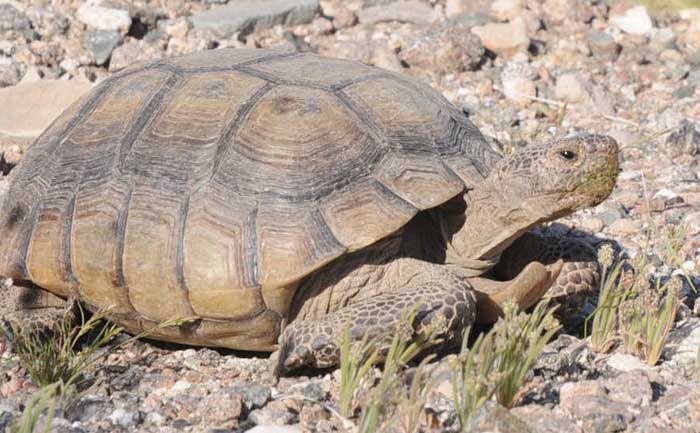
Translocation of tortoises is expected to begin in September is all permit applications are approved (US Fish and Wildlife Service only allows tortoises to be translocated September 1 to October 15, and April 1 to May 31). Blood samples will be collected from all tortoises to determine their health status.
Translocation sites have been identified as three different areas: some tortoises would be moved to the Mojave National Preserve south of the project, in an area bounded by Nipton Road, Ivanpah Road, and Morning Star Mine Road, in an area already designated as critical habitat. Other tortoises would be placed west and north of the project.
BrightSource is being given the option to either fence off the entire area, or in phases, with tortoise fencing. After fencing, each phase would undergo a "clearance survey" -- the first in Fall 2010 -- where teams of contractors remove all tortoises, finally digging up every burrow to get at those underground. This in itself is a destructive endeavor. Construction will take three years, meaning some tortoises might end up being fenced in until dug out of their burrows.
In addition, at least 50 miles of roads will be fenced to exclude tortoise from traffic, and 50 off-road vehicle routes will be restored, as part of "enhancement" efforts for tortoise recovery. A "head-start" program may also be funded, where juvenile tortoises are kept in caged pens in the wild until they are large enough to be released.
Rare plant compensation will amount to $109,613, and Streambed compensation to $623,959.
Jim Harvey Spotlights Ivanpah Valley in News Story

^Reporters and film crew at the Chevron photovoltaic site by Lucerne Valley.
April 1, 2010 - Jim Harvey of Alliance for Responsible Energy Policy (AREP) took a couple of reporters to Chevron Energy Solution’s Lucerne Valley Solar Project in San Bernardino County (a 45 MW photovoltaic array on 516 acres, then to one of the SEGS parabolic trough plants in Daggett, and then to the Ivanpah site near Primm.
At Daggett, the former power tower project was de-commissioned and removed. The entire site was empty, Harvey reported. "They cleaned every piece of broken glass."
"After hearing how 'disturbed' the Ivanpah site was..." noted Harvey, "they were quite surprised to see how healthy and green the site really is, to say the least. Same with the Chevron site."
He focused the interview on feed-in-tariffs, AB811, the true value of open spaces (including carbon sequestration), BrightSource's differing perspectives, and all the benefits of point-of-use generation.
The story will be distributed through California News Service and UC Berkeley TV at the end of the month.
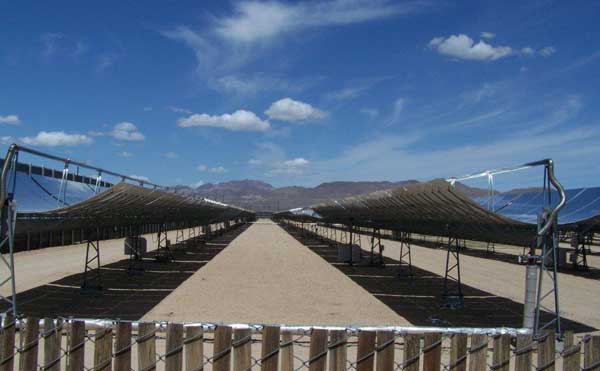
^Visit to SEGS plant in Daggett, east of Barstow in the Mojave Desert. SEGS I and II, built in 1984 and 1985 by LUZ Inductries, are located here. LUZ went bankrupt in 1991.
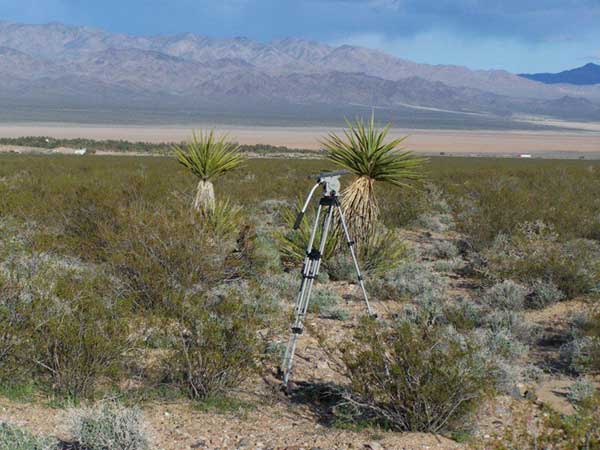
^Film crew at Ivanpah Valley ISEGS project site, where BrightSource (formerly calling itself LUZ2) wants to build a large power tower solar power plant.
Some Satire on Mitigating Habitat
April 1, 2010 - Coyote Crossing by Chris Clarke.
County Voices Pros and Cons of Big Solar
March 25, 2010 - In Riverside at the Governor's Renewable Energy Policy San Bernardino County First District Supervisor Brad Mitzelfelt said State and Federal agencies need to consult and cooperate more with local jurisdictions to ensure that counties and their residents receive benefits from the development of renewable energy projects.
“These large-scale solar and wind energy projects have the potential to create jobs and bring significant economic benefit to local jurisdictions,” said Supervisor Mitzelfelt, who represents much of the Mojave Desert where dozens of renewable energy projects have been proposed. “However, they also have serious impacts on our landscapes and demands for county services, so we need the state and federal governments to bring local government to the table to ensure that these impacts are minimized and the benefits to our residents are maximized.”
Mitzelfelt emphasized that he supports renewable energy for energy independence and some limited local economic benefits, but pointed out that projects being processed by the California Energy Commission and U.S. Bureau of Land Management have not created a mechanism to offset the impacts to local governments on public services such as fire, law enforcement and roads. He recommended that the agencies implement policies to require mitigation agreements with local jurisdictions, or that a standard mitigation fee be established, based on the size or capacity of a power plant.
Requirements for habitat conservation and protection of sensitive species have a very real potential to limit future economic growth if the old model is followed, Mitzelfelt warned. If state and federal agencies require three acres of mitigation land for every one acre that is developed, the entire desert could wind up off limits to future uses such as mining, off-highway recreation, conservation, rock collecting, filming and military training. Just in San Bernardino County, there are proposals for wind and solar projects that would cover more than a half-million acres of land.
Supervisor Mitzelfelt warned that the traditional mitigation strategy of simply buying private land and turning it over to the government could cause grave economic harm to local economies, and instead called for management strategies designed to protect species and help them recover, such as control of predators that are devastating desert tortoise populations.
From JoinBrad.com, Blog of Supervisor Mitzelfelt.
Protest Hike
March 20, 2010 - A group of about 20 people interested in the conservation of the Mojave Desert in Ivanpah Valley gathered to hike, explore, and camp out in this beautiful place that we have come to know well. We learned from a Chemehuevi elder who came out from Needles, California, that "Ivanpah" means "clean water" in native languages, referring to local springs of fresh water that people have cared for and depended on for thousands of years.
Black-throated sparrows and Cactus wrens sang from the creosote, and six Turkey vultures soared overhead migrating northward. The wildflowers were emerging, just green rosettes still, but cold weather has delayed the bloom. April will reveal a colorful display.
Las Vegas Sun Covers Ivanpah Protest Hike >>here
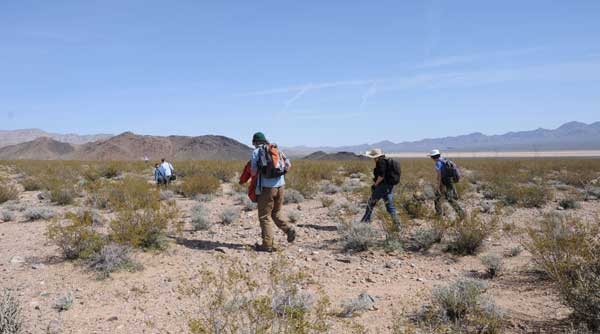
^Hikers explore the Ivanpah solar project site on a beautiful brisk spring day, looking for tortoise and enjoying the day outside.

^Success! A large healthy female tortoise was found at 11 AM, March 21, just emerged from her burrow. Shy, she hid her head back in her shell when she saw us. We took only photographs and left her alone to bask in the warm sun.

^The tortoise sits at her burrow next to a stately Pencil cholla, on the lower fan just east of the Ivanpah solar project site. This entire valley is excellent tortoise habitat, and should not be fragmented by large-scale developments of any kind.
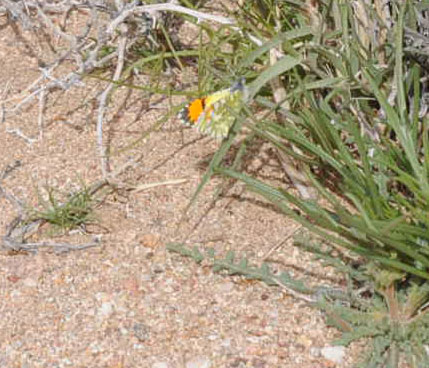
^The butterflies were out today. Pima Orange-tip (Anthocharis cethura pima) - found in far eastern California Mojave Desert into Arizona. Host plants are mustard family (Brassicaceae), of which I saw a few plants coming up, including Tansy-mustard (Descurainia sp.) and another, possibly Streptanthus, all native.
Blog Trip Reports
March 19, 2010 - Save the Ivanpah Valley - Morongo Bill's Back Porch >>here.
March 16, 2010 - Morongo Bill's Excellent Trip Report ! >>here.
Buy American? BrightSource Says Not Necessarily
March 12, 2010 - Different energy industries are competing with each other for a chunk of the renewable pie. The House and Senate Energy and Natural Resources Committee passed a Renewable Energy Standard (RES) that would order utilities to generate 25% of their power from renewables by 2025. The natural gas industry wants lawmakers to expand that to a "clean energy standard" that would allow utilities to count the emissions they eliminate by using gas instead of coal, because natural gas emits less carbon. Some versions would also allow utilities to count emissions they reduce by using nuclear power. Other Democrat's versions of an energy bill even include offshore drilling.
Renewable energy developers protested the idea of expanding the RES in congressional energy legislation to benefit natural gas and nuclear energy, saying it risks sinking the whole concept.
CEO of BrightSource Energy John Woolard said, "Politically speaking, it would be disastrous. Any time you start from scratch it makes it harder to succeed."
Speaking at the CERAWeek energy conference in Houston, Woolard complained that it is too late in the game to make such a substantial change to the legislation.
ConocoPhillips CEO Jim Mulva criticized the RES as too expensive. "Why not instead implement clean energy standards? Then let renewable energy, natural gas, clean coal and nuclear power compete."
BrightSource's Woolard said that the legislation by Sen. Charles Schumer (D-N.Y.) that would restrict energy grants to companies relying on materials manufactured in the United States would bring the program to a halt.
"It stops the whole industry," Woolard said. "Banks would no longer finance these projects."
Many Congressmen were angered by the Investigative Reporting Workshop at American University study that found 79% of the $2 billion in renewable energy grants given out from the stimulus went to foreign companies.
Woolard said he did not know where the Ivanpah solar project's materials would come from. He said that would be handled by Bechtel Group Inc., which will carry out engineering, procurement and construction. He said he expected that Bechtel would buy from standard vendors like General Electric Co. and Alstom because of their competitiveness.
"Bechtel looks at the whole supply chain," Woolard explained. "Philosophically, we're focused on doing as much as possible in the United States."
Woolard said he hopes to begin construction in the fourth quarter of 2010.
Energy and Environment Daily >>here.
Bechtel Signs Contracts with Unions
Ivanpah Valley, California and southern Nevada area -- From the February issue of the local Operating Engineers Union newsletter: Bechtel was awarded the Ivanpah Solar Electric Generating System on the California-Nevada border, in San Bernardino County, California. The first phase 110-MW project is scheduled to begin construction "early this year" (if BrightSource can weave its way through the permit maze and opposition by environmental groups). The second phase is scheduled six months after the start of the first phase. The third phase would complete construction.
According to the Union newsletter: "Business manager William C. Waggoner, Vice President Ron Sikorski and myself [Mickey J. Adams, President] concluded negotiations with with Bechtel's Labor Relations Director Regi Phelps on construction of the project and also on the Assembly Fabricator Agreement -- called the Heliostat Agreement -- which operating engineers, carpenters and electricians will assemble. The total cost of construction and assembly is approximately $2 billion. Bechtel has also signed with the Riverside and San Bernardino Building Trades."
BrightSource Interviewed on FOX Business
March 4, 2010, Bacara Resort and Spa, Santa Barbara, California -- In an interview with Fox Business reporter Brian Sullivan at the Wall Street Journal ECO:nomics conference, John M. Woolard (president and CEO of BrightSource Energy) discussed the Ivanpah Solar Generating System in the Mojave Desert of southeastern California. Mentioning the contract with Bechtel to construct the now three power tower solar thermal plants, the DOE loan guarantee (see below), and some of the technology, Woolard was asked, "But is it going to happen?" He replied, "It's going to happen."
The three power towers would be the largest solar thermal power plants in the world, he stated, all together on one site.
We would like to point out that BrightSource still has an upward climb to resolve numerous environmental impact and mitigation issues, including threats to desert tortoises and rare plants. They also have not made public their plan on how they will secure heliostat foundations to withstand floodwaters that will be allowed to flow through the solar field. The company experienced problems when trying to drive in poles into the bouldery substrate.
The conference convened "top chief executives, policy-makers and thought leaders to assess the urgent risks and new opportunities in markets impacted by the environment."
Mr. Woolard gave a talk on "Renewables in the Recession" along with Gabriel Alonso, CEO of Horizon Wind Energy. Woolard is a lifetime member of the Sierra Club.
Patricia Mulroy, General Manager of Southern Nevada Water Authority, gave a talk called "Water Works". We wonder whether she is scheming water deals for "water battery" proposals that would supposedly store energy produced from wind farms Perhaps BrightSource, too, wants in on Nevada groundwater for their proposed Coyote Springs power tower plant (the failed new city by Harvey Whitemore).
Dr. Steven Chu, Secretary of the U.S. Department of Energy was a featured participant, whose talked was titled "Where Will the Administration Place Its Bets?"
Al Gore, chairman of Alliance for Climate Protection, and T. Boone Pickens, chairman, BP Capital Management were in attendance. James E. Rogers, CEO of Duke Energy, Lewis Hay, III, Chairman and CEO of FPL Group, and Eric Schmidt, CEO of Google, were also there.
Big investor Vinod Khosla, of Khosla Ventures Managing Partners and founding member of Sun Microsystems, told Sullivan that he would not invest in any company that needs long-term subsidies. If it takes 5 to 7 years to get it on its feet, "no problem." But Khosla said he wants a company to be competitive in the real-world market. He does not want an industry propped up by government funds (as much of the solar thermal industry will be, we add).
The sponsors of the conference includes Chevron, Shell Oil Company, FedEx, Intel and Vestas (a wind company).
"ECO:nomics is a highly collaborative event that explores some of the leading ideas linking energy and the environment, and Chevron is delighted to help support this innovative conference," said Russ Yarrow, general manager of California corporate affairs, Chevron (>>here).
See Wall Street Journal Executive Conference - ECO:nomics, Creating Environmental Capital.
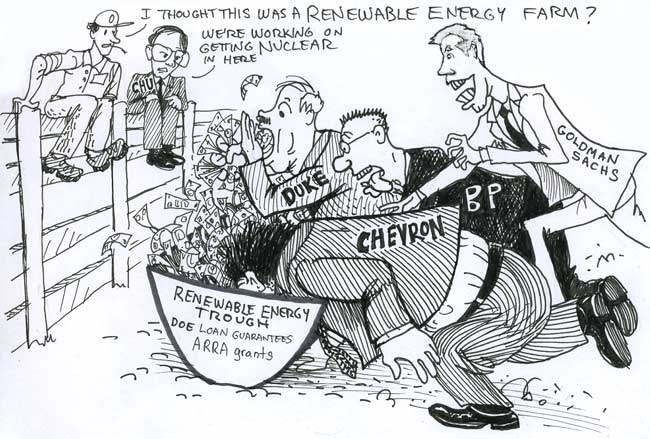
$1.37 Billion DOE Loan Guarantee Given for ISEGS
February 22, 2010, Washington D.C. -- Department of Energy Secretary Steven Chu announced conditional commitments for more than $1.37 billion in loan guarantees under the American Recovery and Reinvestment Act to BrightSource Energy, Inc. to support the construction and start-up of the 400 MW Ivanpah Solar Electric Generating System.
“This is an investment in American jobs and the clean, renewable energy our economy needs,” said Secretary Chu. “We’re not going to sit on the sidelines while other countries capture the jobs of the future – we’re committed to becoming the global leader in the clean energy economy,” he said.
BrightSource estimates that the construction of this complex will employ approximately 1,000 people, and its operation will create 86 permanent jobs. BrightSource’s construction contractor has entered into project labor agreements with various trade unions for the construction of the project.
The loan guarantee is conditioned on financial and environmental requirements BrightSource must meet before closing on the loan, including local, state and federal regulatory approvals. The Bureau of Land Management will continue leading a National Environmental Policy Act (NEPA) review with support from the Department of Energy. Today's announcement does not affect that process.
The first plant is expected to begin construction in the second half of 2010 and come on line in 2012. Commercial operation for the second plant is slated for mid-2013 and the third later in 2013. Electricity from the project will be sold under long-term power purchase agreements with Pacific Gas & Electric and Southern California Edison Company (SCE).
The conditional commitments contemplate that the Federal Financing Bank will provide the financing for the project. Before offering a conditional commitment, DOE takes significant steps to ensure risks are properly mitigated for each project prior to approval for closing of a loan guarantee. The Department performs due diligence on all projects, including a thorough investigation and analysis of each project’s financial, technical and legal strengths and weaknesses. In addition to the underwriting and due diligence process, each project is reviewed in consultation with independent consultants.
This is the sixth conditional commitment for a loan guarantee for clean and renewable energy projects entered into by the Department’s Loan Programs Office, which manages the nation's green energy loan portfolio. This conditional commitment is another step toward making the United States a worldwide leader in the manufacture and deployment of green-energy technology. For more information, please visit the Loan Guarantee Program website.
From U.S. Department of Energy News.
The Washington Post observes: "The solar plant is on federally owned land. So, while the Energy Department is seeking to promote the project, the Interior Department's Bureau of Land Management is supposed to be protecting the area."
Basin and Range Watch reader Joe Orawczyk comments: "Once we (taxpayers) provide the 'loan guarantees' to these remote solar developers, they will have effectively externalized their financial risk for their proposed projects. Because if they or their projects go belly up, their investors are protected from paying for the failure by our government underwriting it with our taxes. Hence, financially speaking, it will serve in the best interest of the taxpayer to see the project to fruition, lest we absorb the cost.
"We pay for part of the project with government subsidies called grants, we provide the public land, we sacrifice the water, we pay utilities for new power lines which would not be needed if solar panels were on our roof tops instead of mirrors in some remote site, we pay a higher price for the end product along with increased taxes on it, and with government loan guarantees we get stuck holding the check if the band stops playing. What a sweet deal for these foreign developers and their investors. -- Local PV is the better answer."
Blog Activity
February 11, 2010 - Letter to Bureau of Land Management on the beauty of Ivanpah Valley, on the Desert Blog by Chris Clarke >>here.
February 10, 2020 - Ivanpah Hearings Underscore Brightsource's Poor Site Choice; Reluctance to Fund Mitigation, on the Mojave Desert Blog by Shaun >>here.
BrightSource Changes Design - Reduced
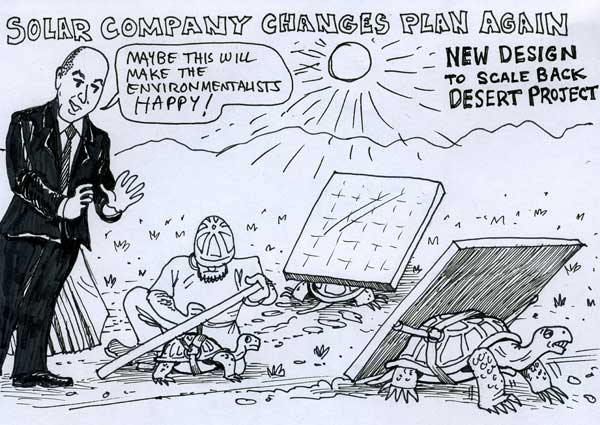
February 11, 2020 - "BrightSource Energy on Thursday plans to submit a new design to regulators that shrinks the size of the 4,000-acre Ivanpah Solar Energy Generating Station by 12 percent, reducing the number of desert tortoises that must be relocated and avoiding an area of rare plants" writes Green Inc. blog (New York Times).
The power plant’s electricity generation would fall from 440 megawatts to 392 megawatts. The Ivanpah 3 power plant in the northern part of the project site would be reduced from a complex 5-tower design down to a one-tower plant.
On urging from California Energy Commission biologists, BrightSource agreed to re-design their solar thermal project because of the high number of rare plants clustered in that part of the valley.
Energy Commission staff consider impacts to five rare plants: Mojave milkweed (Asclepias nyctaginifolia), Desert pincushion (Coryphantha chlorantha), Nine-awned pappus grass (Enneapogon desvauxii), Parish’s club-cholla (Grusonia parishii), and Rusby’s desert-mallow (Sphaeralcea rusbyi var. eremicola) to be significant according to California Environmental Quality Act (CEQA) guidelines because the project would eliminate a substantial portion of their documented occurrences in the state. Other rare plants also occur in the project site: Small-Flowered Androstephium (Androstephium breviflorum), Utah Vine Milkweed (Cynanchum utahense), and Desert portulaca (Portulaca halimoides).
The original plan would have BrightSource biologists try to collect seed from these species as well as try to transplant live plants into an on-site nursery. But the California Native Plant Society considers translocation of wild plants to be risky and usually not effective. Especially rare species that could suffer sever hits by the project, would be fenced off within the heliostat field, in what CEC biologists called "plant corrals," and idea met with much skepticism by both staff and environmental groups.
Botanist Dr. Bruce Pavlik, Professor of Biology at Mills College in Oakland, California (author of the recommended book "The California Deserts: An Ecological Rediscovery") gave a public comment by phone concerning this during the January evidentiary hearing on ISEGS at the California Energy Commission in Sacramento.
He said transplanting rare plants is a great challenge in the desert, from his experience. At the huge open-pit Viceroy Mine in the Castle Mountains (an inholding within Mojave National Preserve), results of extensive salvage and translocation efforts were poor.
BrightSource did good survey work at the site, he noted, but he had concerns with the mitigation. The science of plant conservation and restoration relies on trying to conserve populations, not individuals. A population is defined by seeds in the soil seedbank, lying dormant waiting for the right weather conditions. Surveys will only uncover the existing above-ground population, not the total population. He also mentioned that the surveys for ISEGS were done in two years of below-average rainfall.
Putting up fences around plants is not conserving the population, he urged. "This would be a bad precedent."
After a big rain event, the annual six-awned pappus grass "miraculously" arose out of the ground, where it had not been noted in these numbers previously. But perennial plants can also do this. Pavlik explained that populations exist in some places that we do not know -- we should not define the population by existing plants. Milkweeds are known to have long dispersal distances.
Genetic diversity should be a main concern for plant species. This is key to maintaining resilience in response to climate change, and a lot of genetic diversity could reside in the seedbank. Populations are not static, he concluded, and open habitat should be maintained to allow populations to respond to environmental fluctuations.
Because of these concerns, BrightSource tried to reduce the impact to rare plants which are densest in the northern area, by moving out of these places. But this does not take into account the seedbank.
As for tortoises, they are more evenly distributed across the entire site, and they move all over. This re-design does nothing to truly conserve this threatened population in Ivanpah Valley. A large chunk of habitat for tortoises will still be removed and degraded, fragmenting the basin.
From our own notes at the hearing, and the New York Times >>here.
See also Mojave Desert Blog's analysis.
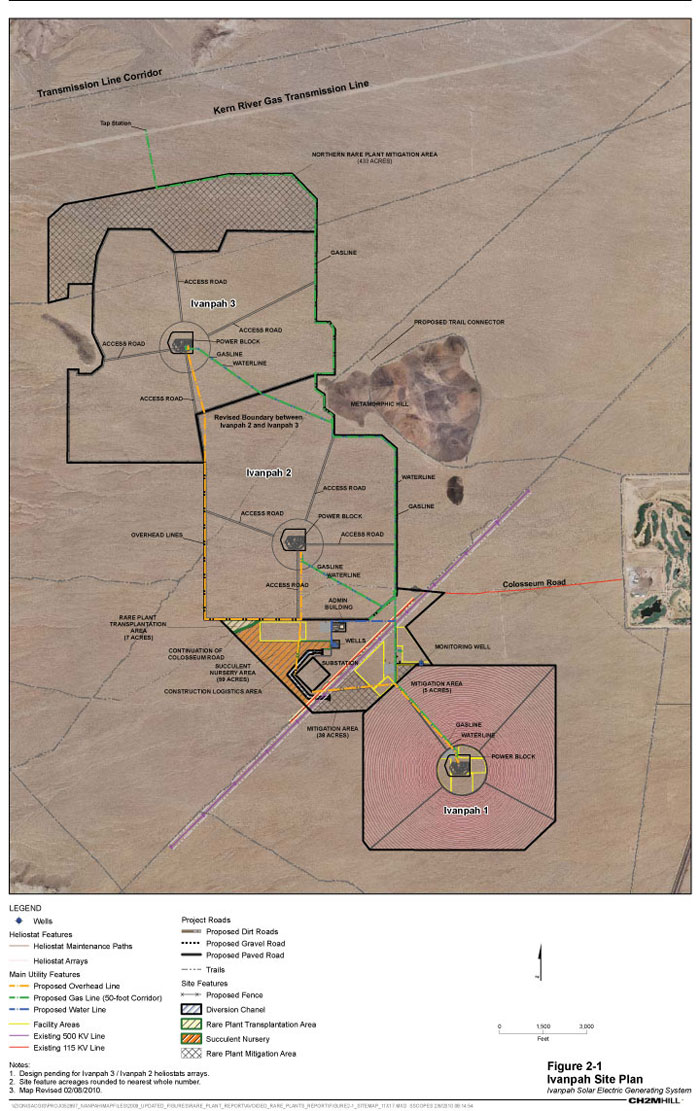
Mitigation map from BrightSource showing their 'generous' deletions of project area (cross-htaching). From the California Energy Commission website, Applicant's Mitigation Proposal, posted February 22, 2010; 3.9 MB pdf.
BLM Open House in Needles
January 21, 2010 - The Bureau of Land Management (BLM) announces an open house to facilitate
understanding of the proposed Ivanpah Solar Electric Generation Project on public lands in San
Bernardino County, California. The open house will be held Thursday, Feb. 4, 2010, from 2 to 4 p.m.
at the BLM Needles Field Office, 1303 South Highway 95, in Needles, Calif. Copies of the Draft
Environmental Impact Statement (DEIS) and California Energy Commission (CEC) Final Staff
Assessment (FSA) for the project will be available for inspection and staff will be available to
answer questions. An opportunity will be provided at the open house to submit written comments.
The official comment period for the DEIS/FSA ends on February 11, 2010.
Evidentiary Hearings in Sacramento
January 11-14, 2010 - Basin and Range Watch members participated in four long days of hearings before the California Energy Commission in the state capitol, California. Six to seven weeks after the close of the hearings, the commissioners will issue their Presiding Member’s Proposed Decision on whether to certify ISEGS, for a 30-day comment period. We will have many stories concerning these hearings at a later date. See the transcript of the first day on this page >>here.
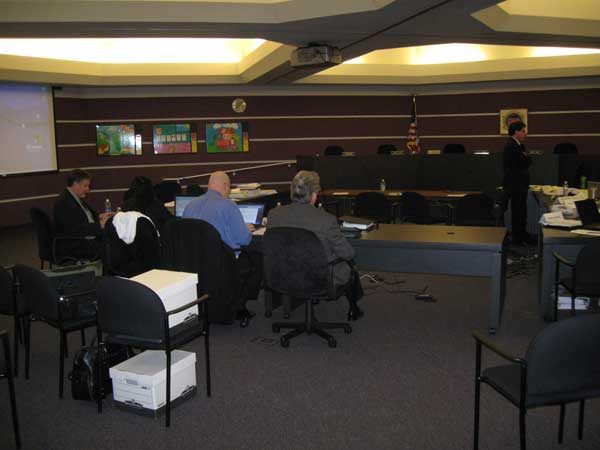
Final Staff Assessment/Draft Environmental Impact Statement Out!
November 4, 2009 -
Ivanpah Solar Electric Generating System is the first utility-scale solar energy project in line to be permitted in California on public land during the current push for renewables. It is the precedent-setter.
The Bureau of Land Management (BLM) and Energy Commission staff announced the release of their roughly 1,200-page Final Staff Assessment (FSA), that combines Bureau of Land Management's Draft Environmental Impact Statement (DEIS). The enormous document may be downloaded at: http://www.energy.ca.gov/2008publications/CEC-700-2008-013/FSA/
BLM still must release its Final EIS. While this accelerates the review process, we have yet to see how BLM will handle its side of the decision to permit the Ivanpah Solar Electric Generating System on public land.
Two Different Comment Periods
1. The California Energy Commission encourages public participation in the review of the
ISEGS Application for Certification and the FSA/DEIS. Written comments on the FSA/DEIS which a member of the public or interested party would like to have entered into the record before the Energy Commission’s Evidentiary Hearing, should be provided to John Kessler, Energy Commission Project Manager, no later than 5:00 p.m., December 7, 2009 at this address:
John Kessler
Project Manager
Siting, Transmission and Environmental Protection Division
California Energy Commission
1516 Ninth Street, MS-15
Sacramento, CA 95814
Phone: 916-654-4679
or by email to jkessler@energy.state.ca.us.
It is crucial that comments be entered into the record.
2. BLM will also be conducting a 90-day comment period in association with BLM’s EIS process, which will be noticed separately. Following completion of BLM’s comment period scheduled to end February 11, 2010, Energy Commission staff and BLM will prepare a Final Environmental Impact Statement (FEIS). The FEIS will respond to public comments and will incorporate any changes deemed necessary to update the analysis of project impacts. Address comments on this Bureau of Land Management EIS to both of the following: Needles Field Office, Attention: George R. Meckfessel, Planning and Environmental Coordinator, 1303 South U.S. Highway 95, Needles, CA 92363. Or email: CA690@ca.blm.gov
This has a "record-breaking" fast deadline. Prehearing conferences will occur in Sacramento on November 18, 2009 and December 10, 2009. The evidentiary hearing would take place on December 15, 2009. Apparently fast-tracking means compressing the timeline of release of the FSA/DEIS and hearings into an unreasonably short space.
We will be reviewing this document and posting our comments shortly.
San Bernardino County Against Ivanpah Project
County Supervisor Brad Mitzelfelt say the massive solar energy project that would cover 4,000 acres should be built elsewhere to protect pristine desert habitat that is home to several endangered species. Mitzelfelt's chief concern, said spokesman Andy Silva, is that the project would monopolize too much desert tortoise habitat. When a project affects desert tortoise habitat other land has to be set aside for tortoises. That means either buying private land or putting more restrictions - such as banning off-roading - on existing public land. If the project were built elsewhere - not in a tortoise habitat - the Ivanpah Valley land could be set aside to make up for land lost to other projects, explained the county.
"When you chew up this much ... land, it makes it that much harder for the next project," Silva said.
In a statement, Mitzelfelt said the project would use San Bernardino County resources but likely wouldn't provide jobs or power for the county.
"This project would create jobs for mostly Las Vegas and electricity for mostly San Francisco at the expense of Southern California's Mojave Desert," Mitzelfelt said.
"It's habitat for a lot of critters," added Eldon Hughes of the San Gorgonio Chapter of the Sierra Club. "There are better places to put solar energy."
Story in the San Bernardino Sun >>here.
Distributed Generation Eliminated as an Alternative
November 14, 2009 -
See the Final Staff Assessment text by the California Energy Commission and where to send comments >>here.
Draft Environmental Impact Statement Due Out, but Tortoise an Obstacle
October 3, 2009
The California Energy Commission (CEC) and Bureau of Land Management (BLM) announced on September 24 that they had completed the Administrative Draft of the Final Staff Assessment (the CEC's review) and Draft Environmental Impact Statement (the BLM's parallel review) of BrightSource's proposal to place a giant solar thermal energy complex on 4,000 acres of BLM land adjacent to Mojave National Preserve, in Ivanpah Valley. The FSA/DEIS would circulate for about three weeks for approval from Washington BLM and Sacramento CEC offices before its public release.
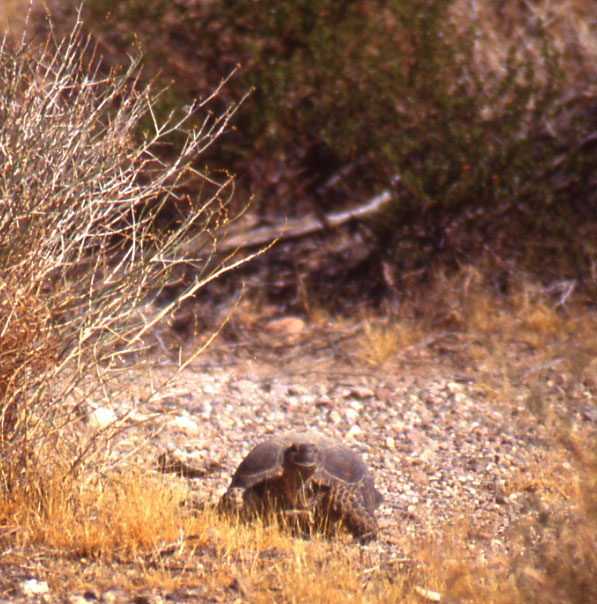 A sticking issue, however, was the Desert tortoise, a federally threatened reptile inhabiting the fan where the utility-scale solar power tower would be built. "Significant outstanding information" regarding mitigation for the tortoise was described by the CEC in a memorandum (60 mb pdf file >>here), especially "analyses and permit requirements" from the California Department of Fish and Game.
A sticking issue, however, was the Desert tortoise, a federally threatened reptile inhabiting the fan where the utility-scale solar power tower would be built. "Significant outstanding information" regarding mitigation for the tortoise was described by the CEC in a memorandum (60 mb pdf file >>here), especially "analyses and permit requirements" from the California Department of Fish and Game.
Therefore, CEC decided to bypass Fish and Game and develop its own "desert tortoise mitigation measures" in accordance with the California Environmental Quality Act. "Staff considers the mitigation approach described in the Administrative Draft to be adequate to satisfy state and federal requirements for mitigating impacts to desert tortoise," the CEC proclaimed. We are not so sure.
^Ivanpah Valley tortoise.
Tortoise Relocation Plan
August 12, 2009
A Draft Desert Tortoise Translocation/Relocation Plan was developed by BrightSource in summer 2009, to move all tortoises from the project site onto approximately 4,065 acres of adjacent Bureau of Land Management (BLM) land - a 1:1 land mitigation scheme. The California Department of Fish and Game (CDFG) commented that no information was provided that describes the density of resident desert tortoise at the proposed relocation/translocation sites. In response BrightSource sent out a subcontractor, Southern Nevada Environmental, Inc., to conduct surveys of the scattered translocation areas in Ivanpah Valley (giving no dates or times in their results >>here, a 27 page, 4.2 mb pdf). They claimed to have completed "100 percent coverage surveys" for desert tortoise, interpreting their data to indicate that density of desert tortoise in the area is low and that "translocation into sites N1 through N4 would not overburden the existing population."
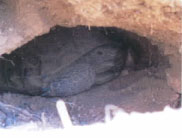 We doubt that an accurate idea of tortoise population density can be obtained except by undertaking more detailed and intensive survey methods, such as line-distance sampling, during spring when tortoise are above-ground more.
We doubt that an accurate idea of tortoise population density can be obtained except by undertaking more detailed and intensive survey methods, such as line-distance sampling, during spring when tortoise are above-ground more.
<Desert tortoise found by contract biologists for BrightSource on their proposed N2 translocation site in Ivanpah Valley. (Source: http://www.energy.ca.gov/sitingcases/ivanpah/documents/applicant/2009-08-13_Supplemental_Data_Response_Set_2J_TN-52847.pdf)
The proposed Ivanpah Solar Electric Generating System would lie within the Northeastern Recovery Unit for the desert tortoise, one of six units designated in the 1994 Desert Tortoise (Mojave Population) Recovery Plan. Studies done indicate these populations have distinct genetic, morphological, ecological, behavioral characters, making them distinct "Evolutionary Significant Units" (US Fish and Wildlife Service, 1994, Desert Tortoise [Mojave Population] Recovery Plan. US Fish and Wildlife Service, Portland, Oregon, 73 pp plus appendices).
CDFG has not yet issued BrightSource an Incidental Take Permit, under the California Endangered Species Act, requiring the "take" (an allowable death of a certain number of tortoises) to be minimized and fully mitigated.
Unfortunately, land managers had earlier left the Ivanpah project site out of critical habitat designation for the Federal and State Threatened desert tortoise, even though density was historically high. BLM had designated portions of Ivanpah Valley as Category 1 desert tortoise habitat in their Northern and Eastern Mojave Desert Management Plan (NEMO), but the northern part of Ivanpah Valley was excluded for some reason.
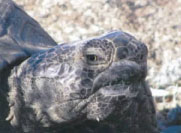 Environmental groups had many comments. Western Watersheds Project and the Sierra Club recommended that the California Energy Commission ensure that the Clark Mountain cattle grazing allotment be retired, and that the existing Desert Wildlife Management Areas (DWMA) boundary be expanded or the area made into an Area of Critical Environmental Concern (ACEC).
Environmental groups had many comments. Western Watersheds Project and the Sierra Club recommended that the California Energy Commission ensure that the Clark Mountain cattle grazing allotment be retired, and that the existing Desert Wildlife Management Areas (DWMA) boundary be expanded or the area made into an Area of Critical Environmental Concern (ACEC).
Basin and Range Watch supports the stand of having no renewable energy projects in Ivanpah Valley desert habitat.
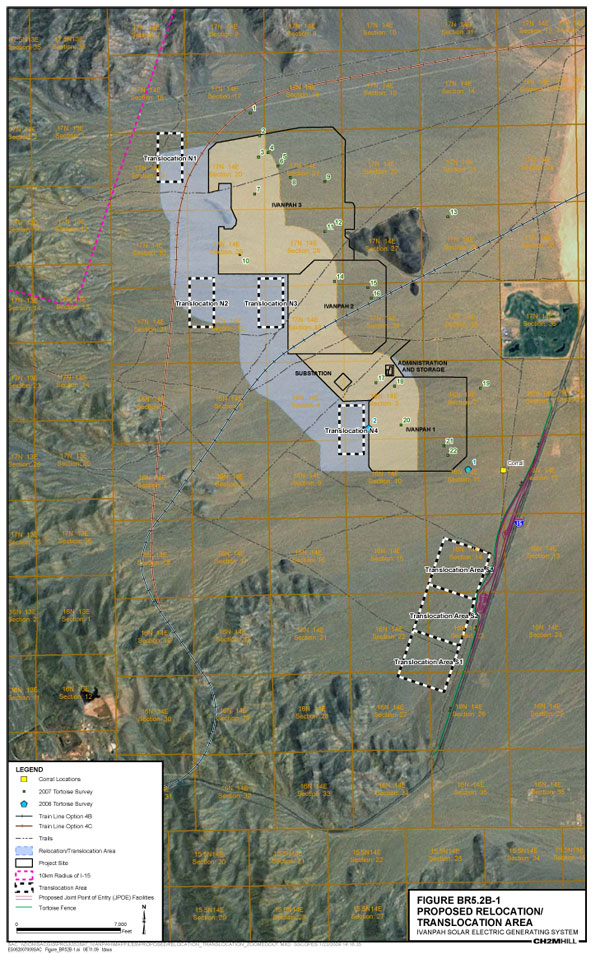
^August 2009 version of the tortoise translocation area map in Ivanpah Valley. Dashed rectangles along Interstate 15, and to the west of the project are the proposed tortoise translocation areas. California Department of Fish and Game, as of October 4, 2009, has not signed off on the plan yet. (Source: http://www.energy.ca.gov/sitingcases/ivanpah/documents/applicant/2009-08 13_Supplemental_Data_Response_Set_2J_TN-52847.pdf)
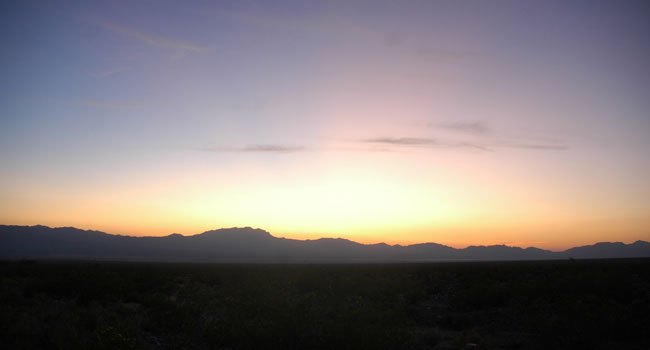
^Summer sunset in Ivanpah Valley, looking west toward Clark Mountain in Mojave National Preserve.
Spring Nights at Ivanpah
June 6, 2009
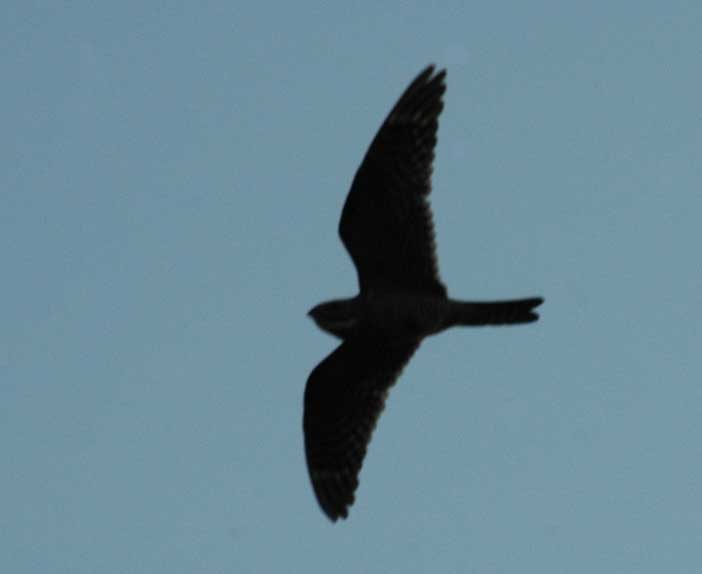 We visited the site of the proposed Ivanpah Solar Electric Generating System in late spring on the night of a full Moon. Life was abundant here as showers passed through days before. On Yates Well Road in the broad creosote flats in the lower basin, 20 to 30 Lesser nighthawks flew about in the dusk light after insects. Some sat on the small road, flying up as we came by. A single Poorwill also flew up from the desert floor.
We visited the site of the proposed Ivanpah Solar Electric Generating System in late spring on the night of a full Moon. Life was abundant here as showers passed through days before. On Yates Well Road in the broad creosote flats in the lower basin, 20 to 30 Lesser nighthawks flew about in the dusk light after insects. Some sat on the small road, flying up as we came by. A single Poorwill also flew up from the desert floor.
Black-tailed jackrabbits (Lepus californicus) dashed about in the evening darkness as stars came out.
As if to show the incredible diversity of life here, a Spotted leaf-nosed snake (Phyllorhynchus decurtatus) was out basking in the residual heat of the little crumbling roadway that will be BrightSource's main entrance road to their project.
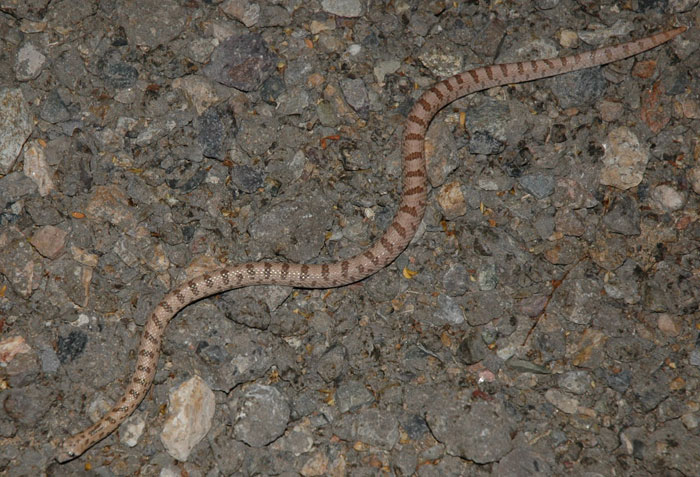
^Spotted leaf-nosed snake in Ivanpah Valley.
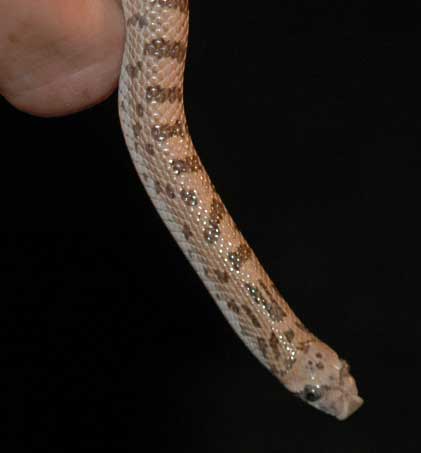
<We took a close look at the snake's enlarged rostral scale which the snake used to burrow into the sandy, gravelly creosote plains that it lives on. They often hunt geckoes.
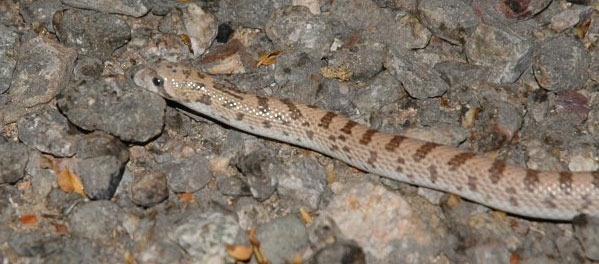
>We put the snake back on the ground and hoped its habitat would not succumb to the perils of poorly planned renewable energy developments.
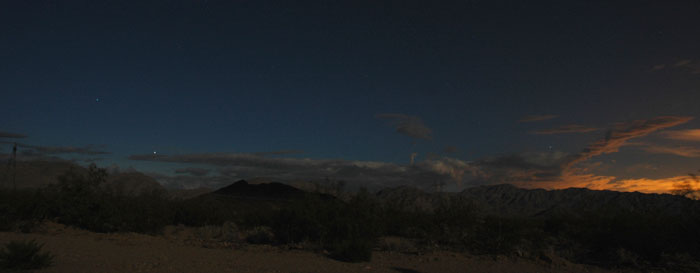
^Night at Ivanpah Valley, with the Clark Mountain Range in the background and Stateline Wilderness. The glow of Las Vegas is to the far right.
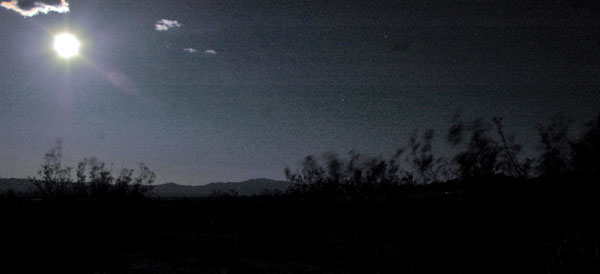
^June full Moon at Ivanpah.
Major Changes to Plan
April 16, 2009
From: California Energy Commission - April 15, 2009
Perhaps realizing the massive amount of landscape degradation that would take place to construct this large-scale solar thermal energy plant in the Mojave Desert, BrightSource of Oakland, California, has changed its plans for grading and drainage at the Ivanpah Valley site in San Bernardino County.
The former plan of development submitted to the California Energy Commission (CEC) and Bureau of Land Management (BLM), which manages Ivanpah Valley, would have required grading almost 4,000 acres of pristine desert to place heliostats: mirrors on posts reflecting sunlight towards central "power towers" that heat fluids to generate steam at adjacent steam engine power plants. The desert would have been scraped bare in a huge swath. (See >>here)
But this neat industrial scheme must deal with some complications: flash floods coming off Clark Mountain, the Federally protected Desert tortoise, and dense vegetation -- all the cacti, yuccas, creosote, wildflowers, and other plants that store carbon and help buffer the effects of Global Warming. Ploughing all this up would release stored carbon in the vegetation and soil microfauna and flora. This is rather a paradox since renewable energy projects like that at Ivanpah are supposed to help reduce carbon emissions into the atmosphere.
So the planners are rethinking some of their macro-manipulation of the landscape.
The California Energy Commission memo says: "The complexity of this large project on a sloping alluvial fan below a mountain range has required several rounds of BLM/Energy Commission
data requests and interaction with the applicant. The grading and drainage plans currently under development are necessary to define the physical layout of the project and the extent of ground disturbance with respect to site grading and drainage features. These plans will enable BLM and Energy Commission staff to assess project impacts and to identify impact avoidance and mitigation measures. Similarly, development of a comprehensive Biological Resources mitigation plan for protecting wildlife and rare plants is critical to BLM and Energy Commission staff’s preparation of the Final Staff Assessment/Draft Environmental Impact Statement (FSA/DEIS). The information developed under the grading and drainage plans is pivotal to the applicant’s ability to progress to preparation of subsequent plans and permit applications, many of which can be developed
concurrently."
"Because the draft plan primarily listed options for rehabilitating the site after project closure, and did not address what the applicant actually proposed in a manner sufficient to protect and restore soil and vegetation resources, it needs to be revised ..."
BrightSource filed its draft Desert Tortoise Translocation and Relocation Plan on March 19, 2009. Staff representatives of BLM, US Fish and Wildlife Service, California Department of Fish and Game, and the Energy Commission "are currently preparing comments to the draft plan and expect to provide comments to the applicant in late April."
We eagerly await the release of the new plan, as it appears that BrightSource is trying to leave desert shrubs and other vegetation more intact. Are they proposing to place the heliostat mirrors among the cacti, creosote, and yuccas? The new plan also seems to seek to build around the numerous washes that flow through the project area down the fan, instead of building berms and drainage channels to alter the flash floodwater flow away from the large mirror areas.
The memo says: "The applicant has developed an alternate approach to its grading and drainage plans differing from those submitted previously, by applying low-impact development principles for its revised plans. The approach seeks to minimize grading and disturbance to existing vegetation, and to have stormwater move through the site according to its natural drainage patterns within the ephemeral washes. The applicant plans to design the pylons supporting the heliostats so as to resist damage from stormwater flows by driving them deeper underground. This is intended to ensure that changes in the course and depth of the washes over time will not significantly affect the integrity of the heliostats. The use of this revised low-impact development plan eliminates previously contemplated drainage control structures and allows applicant to fill in additional space with heliostats, increasing the total number from approximately 240,000 previously to 280,000 as currently proposed."
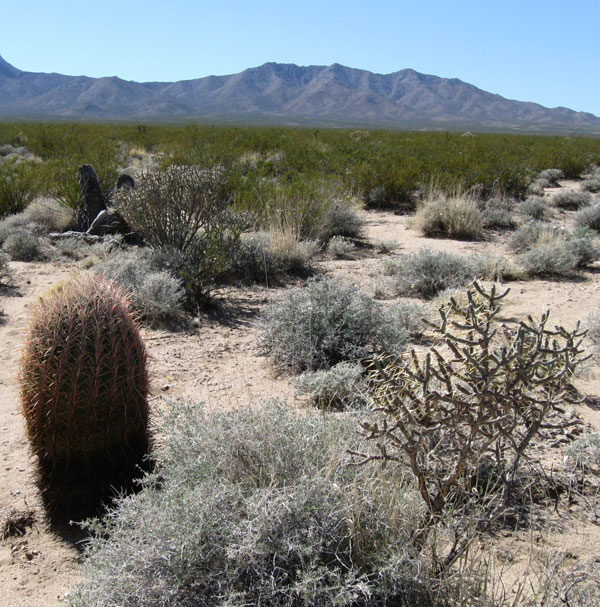
The Sacramento energy folks and BLM seem somewhat skeptical.
The memo says: "The applicant is also exploring equipment and site access options that would be used during construction that minimize site disturbance. While staff is encouraged by the revised site preparation approach overall, it is necessary for staff to evaluate and for the applicant to demonstrate that multiple assumptions in the low impact design are reasonably achievable. These include assumptions that vegetation changes will not significantly alter stormwater runoff, and that the heliostat field construction can be accomplished without significantly removing or damaging vegetation."
The Energy Commission and BLM are also asking BrightSource to do a groundwater study to evaluate the potential for migration of brackish groundwater westward towards the existing and proposed project wells due to pumping by the Ivanpah project for its water needs.
Other problems have come up with how to mitigate Desert tortoise habitat destruction, and how land for translocated tortoises would be found and preserved. BLM and California Department of Fish and Game have differing criteria "for biological resources mitigation so that habitat
compensation lands for desert tortoise can meet the requirements of both agencies..."
See the memo update >>here.
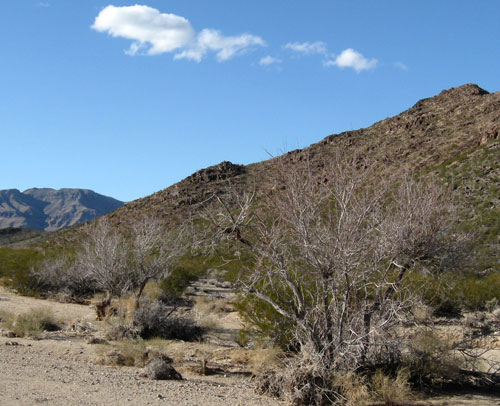 <Catclaw acacias in winter.
<Catclaw acacias in winter.
HOME....Updates Page 2....Ivanpah Original Plan of Development....Last Spring at Ivanpah?
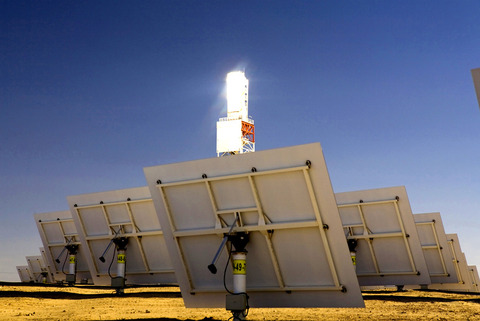 Ivanpah Solar Electric Generating System Updates
Ivanpah Solar Electric Generating System Updates